Wallace, Robert F., and Jeffrey G. Barlow. 2001. From Dam Neck to Okinawa: a memoir of antiaircraft training in World War II. Washington: Naval Historical Center, Dept. of the Navy.

The Navy Department Library
From Dam Neck to Okinawa: A Memoir of Antiaircraft Training in World War II
By Robert Wallace
Edited by Jeffrey G. Barlow
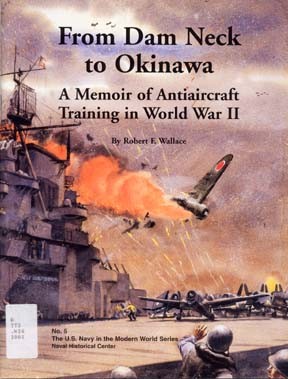
No. 5
The U.S. Navy in the Modern World Series
Series Editor
Gary E. Weir
Head, Contemporary History Branch
Naval Historical Center
Department of the Navy
Washington
2001
Secretary of the Navy's Advisory Committee on Naval History
Dr. David Alan Rosenberg, Chair
CDR Wesley A. Brown, CEC, USN (Ret.)
Dr. Frank G. Burke
VADM Robert F. Dunn, USN (Ret.)
VADM George W. Emery, USN (Ret.)
Dr. Jose-Marie Griffiths
CAPT R. Robinson Harris, USN (Ret.)
Dr. Beverly Schreiber Jacoby
Dr. James R. Reckner
Dr. William N. Still, Jr.
Ms. Virginia S. Wood
Library of Congress Cataloging-in-Publication Data
Wallace, Robert F.
From Dam Neck to Okinawa : a memoir of antiaircraft training
in World War II / by Robert R Wallace.
p. cm. - (The US Navy in the modern world series ; no. 5)
ISBN 0-945274-44-0 (alk. paper)
1. Wallace, Robert F. 2. World War, 1939-1945-Personal narra-
tives, American. 3.World War, 1939-1945--Antiaircraft artillery opera-
tions. 4. World War, 1939-1945-Naval operations, American. 5.
United States. Navy--Officers-Biography. 6. Idaho (Battleship : BB-
42) 7. World War 1939-1945-Campaigns-Japan-Okinawa Island
I. Title. II. Series.
D773.W282001
940.54'25-dc 2001030863
TO LUCASTA, ON GOING TO THE WARS
Tell me not, Sweet, I am unkind
That from the nunnery
Of thy chaste breast and quiet mind,
To war and arms I fly.
True, a new mistress now I chase,
The first foe in the field;
And with a stronger faith embrace
A sword, a horse, a shield.
Yet this inconstancy is such
as you too shall adore;
I could not love thee, dear, so much,
Loved I not honour more.
Colonel Richard Lovelace
1618-1657
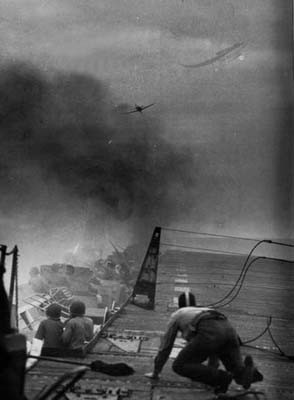
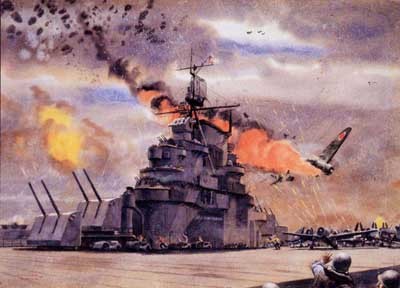
Foreword
This study is the fifth in the Naval Historical Center's series, "The US Navy in the Modern World," which seeks to acquaint naval officers, sailors, and other readers with the US Navy's unique contribution to national life and history in the contemporary period. During World War II, the US Navy engaged in a massive expansion of its fleet and shore establishment in support of the Allied effort to challenge the Axis powers in Europe, the Middle East, and Asia. A significant but unheralded aspect of this naval buildup was the creation of a successful training organization of immense size and complexity. This memoir offers a unique perspective on the effectiveness of the training program developed to enhance the fleet's antiaircraft defense. The author, wartime reserve officer Robert F. Wallace, served from the fall of 1942 through the fall of 1944 as an instructor at two Atlantic Fleet antiaircraft training centers (AATCs) before joining the battleship Idaho (BB 42) as the automatic weapons officer. He served on board Idaho through the pivotal battles of Iwo Jima and Okinawa. In writing his reminiscences, Dr. Wallace supplemented his detailed memories of these events with the written recollections of his former AATC colleagues and shipmates as well as Idaho's war diary and action reports. The result is a remarkably interesting look at a specific type of wartime training and the invaluable results it produced in combat. In addition to Dr. Wallace's efforts, I am pleased to acknowledge those individuals at the Naval Historical Center who contributed to this publication. Dr. Jeffrey G. Barlow, a historian with the Contemporary History Branch, provided continual encouragement to the author during the writing process. He verified the accuracy of the historical information in the memoir by using documentary materials at the Center and at the National Archives, did the initial editing of the manuscript, and obtained many of the photographs used. Others who participated in the effort included Dr. Edward J. Marolda, the Senior Historian and founder of the series, who first expressed an interest in its publication; Sandra J. Doyle, the Center's Senior Editor; members of the Curator Branch's Photographic Section; Naval Aviation News An Director Morgan I. Wilbur and Associate Editor Wendy Leland; and intern Katharine Beale. With this fifth contribution, the general editor of the series and head of our Contemporary History Branch, Dr. Gary E. Weir, has embarked on an effort to demonstrate historically the diversity of the Navy's role in the national defense. While earlier contributions focused primarily on operational matters, this memoir by Robert Wallace examines the critical significance of naval training and education. In the future, the "Modern World" series will examine such subjects as crisis response, operations other than war, and regional power projection, as well as the operational themes we have visited in the past. In this way we hope to offer history well crafted and diverse as a truly effective component of twenty-first-century naval training and information. The views expressed are those of the author and are not necessarily those of the Department of the Navy or any other agency of the US government.
William S. Dudley
Director of Naval History
--v--
Preface
It seems a logical question to ask: Why would an old man well into his eighties, who for more than 50 years had given little thought to his own experiences in World War II, now seek to delve into memories of a faraway past? The answer is a story that began in the mid-1990s at the Naval Historical Center. I had gone there to talk with John Reilly, head of the Ships' Histories Branch, about the role of Franklin D. Roosevelt in the building of the famous carriers Yorktown and Enterprise, when Dr. Jeffrey Barlow overheard our conversation and asked to record my reminiscences of World War II. I spent all of the next day telling Jeff much the same story written in this paper
On the following day archivists Gina Akers and Mike Walker introduced me to materials in the Operational Archives, which included war diaries of ships and stations and ships' action reports, as well as extensive biographical records of Navy officers. Librarian Glenn Helm, who was equally helpful, took me through the Navy Department Library, showing me the wide range of materials available and photo copying articles for me. The enthusiasm for my project was contagious. When I recounted these experiences to my daughter, Susan, she insisted that I devote my next article to telling my own war story. As a Pentagon employee, she understood the importance of military history and had been encouraging me to write down my memories. Dr. Barlow provided strong support from the beginning, sending me the enormous amounts of archival material I needed to cover the details.
I spent weeks wondering how to frame the tale. I would be writing about antiaircraft training centers where, in shore duty, I had spent all but twelve months of a naval career that lasted three years and four months. The big question was how to begin the story in a manner that would give it maximum significance. Perhaps I was a bit slow to "catch on" but, as it turned out, my own orders provided the answer. Here I was, a junior lieutenant, newly commissioned from civilian life, without a single day of indoctrination or training of any kind, after exactly six weeks of active duty, ordered to the headquarters of the Commander in Chief of the United States Fleet for a conference. That sort of thing did not happen often. Thomas B. Bail's biography of Admiral Ernest J. King and some investigation by Jeff Barlow revealed that King was concerned about the Navy's inadequate antiaircraft defenses and that he, more so than anyone else in the service, was fully aware of the problems. His approach was imaginative, innovative, and, above all, effective. Admiral King's concerns then would begin my story. In developing the account of shore duty at the antiaircraft training centers, Ed Hills and Gus Greanias gave me great help, providing details from their own records and memories as well as photographs. Unfortunately Larry Springer had died, and I never again had any contact with Julian Eysmans, who in 1942 was already in his forties.
My brief and eventful sea duty on board Idaho was easy to reconstruct, largely because of the documentary material found by Jeff. He was able to give me everything I asked for. From Idaho, I had the detailed recollections of B. W. "Duly" Dulaney, who had been on board for several years and explained things that I had never known. He provided the perspective I was unable to develop in my short time there. I was unable to locate Commander Bishop who, like Julian, would be very old if still alive. These were the people who gave me direct assistance in writing this account, though many others who appear made their contributions to the story. Many fine enlisted men, both in Bermuda and at Price's Neck, Rhode Island, were great friends who helped me in developing my own understanding of the Navy, as was also true on board Idaho where I had wonderful support and help from the many highly skilled gunner's mates and fire controlmen. I often think of the hundreds of mature, dependable crewmembers in their teens and early twenties who make every American warship a formidable organization.
In the preparation of this manuscript I had much able and willing help. Lyla Snow began the typing, but Kathleen Ballweg did most of the work and completed it. Then my good friend Helene Hopkins reworked the entire paper, adding much polish. She had the help of her parents, Professor and Mrs. Jean-Charles Seigneuret, who went over the entire manuscript. Dan Moyer of After Image reworked my own photographs and put them in excellent condition. If after all of this great assistance serious flaws remain, I must accept the blame and perhaps claim the readers' indulgence for the infirmities of advanced age.
Robert F. Wallace
--vi--
Acknowledging the Problem
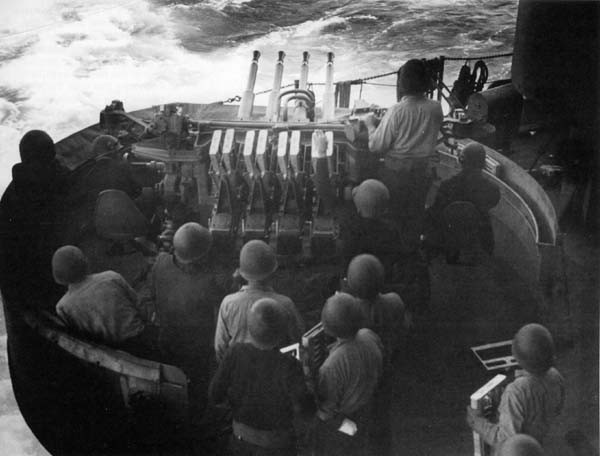
In all the long annals of naval warfare there has never been an assault like the prolonged Japanese air attack against American naval forces in Okinawa. Except briefly in the Java Sea, a day in the Komandorskies, a few dozen engagements during the lengthy struggle for control of Guadalcanal and the Solomons, and a day or so at Leyte, Japanese surface warships rarely attacked US Navy ships. Indeed, in most of the major engagements of the entire war the enemy fleets never saw each other. For every attack by a single Japanese ship, American combatants experienced literally hundreds of air attacks from Japanese planes. In some operations air attacks became routine, often a daily occurrence.
The aerial assault was a new and almost unheard of tactic. At the onset of World War II how then could it have been foreseen and prepared for? According to much popular belief, it was not anticipated. But that view is incorrect. Throughout the interwar period the Bureau of Ordnance (BUORD) and the General Board worked on the development of both heavy antiaircraft guns and automatic weapons of various types to counter aerial assault. An advisory group to the Secretary of the Navy, the General Board was usually the last assignment for dis-
--1--
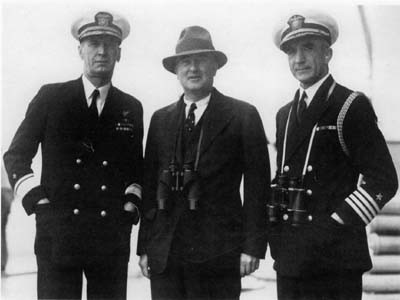
tinguished senior officers before retirement. In July 1939, Rear Admiral Ernest J. King joined the board and, in what may have been one of his greatest but least appreciated contributions to the US Navy, began to revolutionize the backward antiaircraft situation. Resisting the sometimes-relaxed atmosphere of the board, King immersed himself in work looking for problems to solve.
In early 1940, when Secretary of the Navy Charles Edison headed west for a six-week tour of the fleet, President Franklin Roosevelt, who already knew something of King's talents, had the admiral sent along, more or less as a personal tour guide. This duty was the break King needed. As an aviator himself, King had become increasingly aware of the Navy's unreadiness for air attack. Quickly earning Edison's confidence, he received the Secretary's blessing to oversee a complete updating of the fleet's antiaircraft defenses. After several months of ad hoc work by King and three assistants, the process was formalized on 9 August 1940, when the Navy Department set up the Antiaircraft Defense Board. This crucial "King Board" reported on 26 December that lack of adequate automatic weapons was "the most serious weakness in the readiness of the navy for war."
With this drastic assertion, and in true King fashion that would become familiar throughout the Western world, he dominated antiaircraft development, controlling every detail of the work and stepping on all of the toes necessary to get things done. He recommended $300 million for antiaircraft improvements in the fleet, and Carl Vinson's House Appropriations Committee responded with uncharacteristic speed. King personally reviewed the plans of each type of Navy ship and dictated the shipboard installations that would have to be removed to make way for the guns. It was said to be "ruthless surgery," but with the authority conferred by the Secretary he cut through all the usual delays with changes described as "quick and dirty." And that was just the beginning.
When Admiral King took over as Commander in Chief, United States Fleet (COMINCH), a few days after Pearl Harbor, antiaircraft defense remained one of his top priorities. Particularly in the early stages of the war, King had a tendency to micromanage what he regarded as key activities. These included instruction in antiaircraft gunnery at antiaircraft training centers (AATCs), which he kept under his direct supervision until
--2--
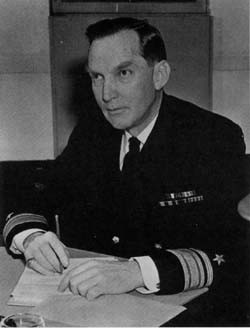
April 1943, when all training in the Atlantic was placed under Admiral Donald B. Beary, Commander Fleet Operational Training Command, Atlantic Fleet (COTCLANT).
According to the 28 March 1942 entry in the US Fleet's war diary, the Instruction Section was located in COMINCH Headquarters' Readiness Division. This section consisted of just two officers, Percival E. McDowell, the antiaircraft commander, and James A. Scott, the assistant antiaircraft commander. These two men ran the AATCs directly out of the COMINCH office. Their modus operandi was often unconventional by Navy standards, and their power was enormous. Scott, though only a captain, had been out in civilian life for some years and hence had once been senior to many of the admirals with whom he dealt, a situation he handled adroitly. His great personal magnetism made him the ideal "out-side man." He was full of anecdotes. Lieutenant Cameron Smith, commanding officer of an offshore AATC, was having trouble with the base admiral who held up AATC mail, including spare parts, insisting it could not go directly to the unit. Captain Scott finally paid the offending admiral a visit. As he later told me, "I put my finger under his nose and I said, 'Johnnie, I am talking to you just the way I did when you were a Plebe!'"
The prototype AATC was the Antiaircraft Training Center at Dam Neck, Virginia, established only about a week before Pearl Harbor by Lieutenant Philip D. Gallery, another highly personable and informal individual, who remained in command there until the end of 1943. In addition to this command, in the informal atmosphere of the program he came to be recognized as the over-all expert and at least once served as a sort of roving ambassador on a manhunt to other AATCs. It was on one such occasion that I came to know him. At least 20 AATCs were established wherever gun crews could use instruction and, later especially, target practice. In addition to several stateside locations, they extended from Guantanamo and Bermuda to Guadalcanal and Guam. All followed basically the same plan-a firing line mounting all calibers of antiaircraft guns, facing the open sea to afford an unobstructed field of fire for towed sleeve targets. Sheds behind the firing line stored the heavy wooden tables for conducting the instruction that preceded the actual firing. Messing and berthing facilities varied with the proximity of the ships and stations being served. Keeping things in proper order, instruction and schedules were always adaptable to the needs and convenience of the fleet. For example, when the young officer with a draft of men from the small carrier Independence (CVL 22) emphasized their trouble with the Japanese "Bettys," his men received all the actual firing practice possible, in contrast with the new recruits whose instruction would first emphasize work in the shop. It was a joy to work in the program because of the enthusiasm and appreciation of our trainees.
My own experience is probably an excellent and typical example of how speedily this program worked in its early, relatively informal
--3--
stage. At age 30, with seven years of college teaching behind me, I volunteered for the Armed Guard without knowing anything about it. The young officer who interviewed me in Chicago asked if I would be willing to go into the Armed Guard. I still remember how surprised I was that in time of war, in military service, I should be asked if I would be willing to do something. I said, "yes," of course, and when he asked if I knew what it was and I said, "no," he explained that I would command a Navy gun crew on a merchant ship. What he did not explain was that this duty was virtually suicidal at a time when German submarines were devastating Atlantic shipping along the American coast with almost complete impunity. Some months later, an old chief gunner's mate who had been training Armed Guard personnel told me he was often called upon to identify the bodies of kids he had sent out only a few days earlier. If I had been reading the New York Times, I might have been able to figure out just how dangerous Armed Guard duty was. And surely the form of his question would have had much greater meaning. But I gave no thought to possible hazards and, like millions of young Americans at the time, I was eager to get into that uniform.
In early summer 1942, I stayed at the University Club in Washington as a guest of my longtime friend and mentor, Army Reserve Captain Joseph H. Taggart, an intelligence officer who clearly knew all about the Armed Guard but never mentioned it to me. I frequently ate dinner with Taggart and a young lieutenant commander (who was killed shortly thereafter) whose name I no longer recall. One evening the lieutenant commander told me he had made an appointment for me the next morning at the Navy Department Building. "I think
"We think we know
guns, but the Navy
has never had such a
teaching problem
and that's where you
come in."
-Lt. Edward C. Spencer, USNR
they may have something for you," he said. But when I remonstrated that I had already been told I would be in the Armed Guard, I clearly remember Joe Taggart's remark, even after all these years, "Well, there are other things."
The next morning at my Navy Department meeting, after a few minutes of small talk and no hint of what it was all about, a commander asked me to stop by Ninth District Headquarters at Great Lakes on my way home to Kansas City. At Great Lakes a certain commander engaged me in yet another brief and mysterious conversation, but I guess I expected such of military life in wartime. At least I was not curious, and in August I received an appointment as lieutenant (jg) and orders to the Antiaircraft Training Center, Price's Neck, Rhode Island. A gunnery station seemed consistent with the Armed Guard, and my innocence remained intact. When I reported to Price's Neck on 31 August, Commanding Officer Lieutenant Edward C. Spencer, USNR, asked, "Do you know what you are here for?" When I said, "no," he took me back to his office and explained that the greatly beefed-up automatic weapons battery of the post-Pearl Harbor navy would require huge numbers of men to be trained in handling the guns. He said, "We think we know guns, but the Navy has never had such a teaching problem and that's where you come in." I had been more or less handpicked as a teacher. My title was to be "Senior Instructor." That was my introduction-no ROTC, no Columbia University "90-day wonder" program, no direction of any kind except by watching and by doing.
The clerks at Woolf Brothers in Kansas City who sold me my uniforms showed me what I needed and how to wear it. Together, we mourned the loss of Ensign Eddie Olsen, my old college friend and their former colleague, who had died in Arizona (BB 39). I remember how disappointed I had been that I could not join Eddie in that new program. I was just too old.
At Price's Neck, I simply went into the shops and learned how to take down the guns and mastered
--4--
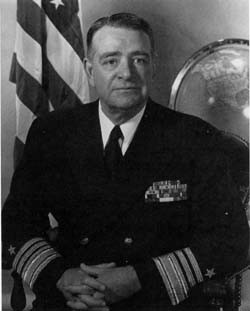
the nomenclature. How well it worked may be suggested by a recollection I have always cherished. We had many visitors, and one morning a small group of current Naval Academy graduates was turned over to me. One particularly charming young man and I warmed to each other as I took them through the 20mm Oerlikon, then new to our Navy. When we took our break for lunch, the young man asked what my year was at the Academy. I explained that I was a reserve officer, but I am sure I never mentioned how long I had been one. (At this point, I had been at Price's Neck just over six weeks.) His comment to me was, "I was impressed." The young man's name was Jim Holloway, and during the following months, when I occasionally met his father, James L. Holloway, Jr., commander of the Destroyer Escort Shakedown Group in Bermuda, I always asked about my new friend and got a report on his latest duty. Although I never saw Jim again, I always remembered talking with him.
On Monday, 5 October, a visiting grayhaired lieutenant, who had spent the day circulating among several trainers like myself, invited me and another colleague to dinner that evening. At the end of the night, he asked me to become his senior instructor at the new AATC in Bermuda where he was commanding officer-designate. Upon my acceptance, in sharp contrast with the "mills of God" that are said to "grind slowly," the wheels now turned rapidly indeed. The next day, the following Bureau of Naval Personnel (BUPERS dispatch reached Price's Neck:
ON OCTOBER 7 LT (JG) ROBERT F. WALLACE D-V(S) USNR PROCEED HEADQUARTERS COMINCH, WASHINGTON, D.C. TEMPORARY ADDITIONAL DUTY CONNECTION CONFERENCE. COMPLETION RETURN.
I left Price's Neck at 1700 on the 7th and reached Washington the next morning at 0900, where I went directly to COMINCH headquarters. It was here that I met Captain Scott, who spent the day with me—no doubt checking me out—and filled me in on my new assignment. My commanding officer was to be Lieutenant Julian L. Eysmans, Jr., USNR, a poised extrovert who had been hand-picked for the duty in the belief that he would fit in well with the British, an expectation that proved entirely correct. Julian had been a public relations man and professional entertainer for the Pennsylvania Railroad, for which his father had been a senior official. In his youth a wastrel (by his own account), Julian had never finished college. BUPERS had, at first, refused him a commission, but Captain Scott said to me, "We just told them COMINCH wants him."
Throughout the war, Dam Neck was considered the model for all AATCs. For an officer like me, just entering the program, a visit there was de rigueur. Accordingly, I was flown down there that very evening on my first plane ride. After spending Friday with Captain Scott at COMINCH and Saturday looking around Dam Neck, I was returned to Washington, D.C., on Sunday, 11 October, and was granted a week's delay and ordered to report the following Sunday for transportation to Bermuda. Julian and I arrived there via the Pan Am Clipper at 1600 on 17 October. Considering the ground covered since my reporting for duty at Price's Neck on 31 August, that journey was probably about as expeditious an operation as one could find in any military organization.
--5--
Teaching at Southlands
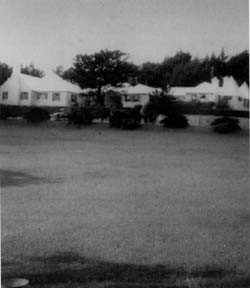
The next morning Ensign Albert A. Springer, USNR, the AATC's executive officer who had preceded us by a few weeks, showed us around our new station. Admiral Jules James, the base commander, had arranged for lease of the 5 5-acre showplace estate, Southlands, at $750.00 a month. Facing the open sea to the south, as the name implied, and located only about five miles from the naval base, it was an ideal location for an antiaircraft training center. It was a sumptuous setting, with the butler, Rawlins, and his housekeeper wife, Mary, administering the house while Shanks, the Scottish gardener, and his dozen or so assistants maintained the acres of lawn and formal gardens. The ample servants' quarters in the carriage house, which originally housed the enlisted men, soon had to be supplemented by Quonset huts, and the carriage house became the preferred location for the senior people. Only we three officers had our meals at the estate. The proximity of the base made it convenient for visiting gun crews, while private enterprise rising to the occasion provided an excellent messing facility nearby for our men.
The firing line, which was rapidly completed, soon included numerous 20mm Oerlikons, both a twin- and a quad-40mm Bofors, and a quad-1.1-inch mount. The firing line grew as time went by. The enlisted men, who were quickly brought in, included a few highly competent gunner's mates and a small number of relatively inexperienced but intelligent young fire controlmen. We were in business—all greenhorns except for a small cadre of junior petty officers. Larry Springer, a very conscientious person, was a superb exec and managed the estate as well as the station. Julian, as anticipated, proved to be excellent in dealing with both the British and the Americans and, knowing nothing whatsoever about guns, turned me loose.
I had been a Navy buff since receiving a beautiful battleship for Christmas in 1917. For a seminar in graduate school, I had presented a paper on the Battle of Jutland. As a "gun-nut" and a lifelong hunter, I was in my element. Since I had been one of the more-or-less observers at Price's Neck, I had learned a good deal about the guns, but from a distance. We did not fire the guns at Price's Neck because that job was for enlisted trainees. For its automatic antiaircraft weapons, the Navy had at first used the .50-caliber Browning machine gun and had developed the quad-1.1-inch, the so-called Chicago Piano. But the .50-caliber came to be considered more effective at punching holes in aircraft skins than in tearing them up, while the 1.1-inch proved to be a disappointment in many ways. A number of critics have mentioned the frequent premature explosions of the excessively sensitive shells within the gun barrel itself. Commander Gallery commented that they would "go off when fired into heavy rain." Our "prematures," like those at Dam Neck, tended to explode just abaft the flash shield, to the great discomfiture of both crew and bystanders. Unlike at Dam Neck, however, we were lucky that nobody ever got hurt in the process. Even if satisfactory ammunition had been developed, our 1.1-inch required the nearly full-time service of a
--6--
gunner's mate first-class to keep it firing with a minimum of jams. My friend Walter Becker of the destroyer Clark (DD 361) recalled that during the carrier Lexington's (CV 2) abortive run at Rabaul in February 1942, a gun captain on the destroyer tried to keep the 1.1-inch going by employing a wooden mallet and a liberal use of profanity. Moreover, as I recall, the empty clips sometimes had to be removed by hand. Compared with a 1.1-inch loader, the proverbial one-armed paperhanger would have appeared to be an idler. We quickly dismissed the 1.1-inch automatic weapon. However, at the suggestion of the imaginative Julian, the "1.1-inch" became a tradition at Southlands as the name of a drink whose deceptive pineapple juice base concealed a delayed-action kick that would have done credit to the gun's eminent successor, the 40mm Bofors.
The light, free-swinging 20mm machine gun, which the Navy adopted in November 1940, was a product of the Oerlikon Machine Tool Works in Switzerland, although our guns were all manufactured in the United States. As automatic weapons go, it was unbelievably simple and almost trouble-free. At a cyclic rate of 480 rounds per minute (rpm), and using a spring-loaded drum of 60 rounds, the machine gun kept firing as long as the firing lever was held back or until something broke. And amazingly, there were only five parts that could break; four of these were located together on the breechblock. It was blow-back operated—the explosion of a round hurled the breech forward against a powerful recoil spring that encircled the barrel and returned the block to pick up the next round extruded from the magazine. As the block returned to battery, it tripped the sear, releasing the rotating hammer that in
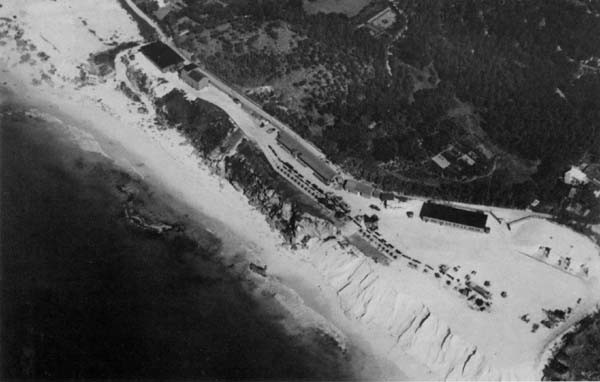
--7--
turn actuated the firing pin to start another cycle. As may be imagined, the face of the block received steady pounding and required a replaceable face piece to absorb the beating. Almost all the breakages occurred in the four-part face piece, the sear, the hammer, or the striker assembly. When the gun stopped firing with the breech closed, the gunner's mate instantly recognized the cause, removed the block, and replaced one or more of the four parts. The only other thing that could possibly break was the barrel spring, and this problem was easy to diagnose because the broken parts jammed against the side plates, holding the breech open and preventing return to battery. Though these occurrences became familiar and seemed frequent in the huge volume of AATC firings, from my own later experience in what seemed like heavy battle engagements, stoppages were rare. Another advantage of the air-cooled Oerlikon was that a man with asbestos gloves could change barrels in about 30 seconds. At the AATCs, we placed water troughs in front of gun mounts. But the Oerlikon was not subject to much overheating, and changing barrels was probably not often necessary during combat. The relative disadvantages of the 20mm were its short range and limited destructive power of its small explosive shell.
The great automatic cannon of World War II was the 40mm Bofors. Surprisingly, this excellent gun had been designed by the German industrial giant Krupp in World War I and became the property of Bofors of Sweden after the war. In early versions used by the British and US armies, it had an air-cooled single barrel. That feature was not exactly what the US Navy had in mind, but the breech mechanism—the heart of any gun—was, along with that of the Oerlikon, about as simple and trouble-free as a machine cannon could be. At the AATCs, firing literally millions of rounds, we experienced almost everything that could possibly go wrong. I still have a yellowed copy of my four-
The Great
automatic cannon of
World War II was
the 40mm Bofors
page mimeographed handout "40 MM CASUALTIES." My paper points out that, in spite of several possibilities, stoppages fell into two cases: breechblock open and breechblock closed, and as with the Oerlikon, this knowledge always gave the gunner's mate a starting point.
We were all experts on stoppages, but when we went to sea, I suspect that my buddies, like me, learned that these guns seldom failed under combat conditions. When that rammer went forward punching a round into the chamber, the breechblock closed automatically, tripping the sear and firing the round. Stoppages were rare. The firing cycle, though a bit more complicated than that of the Oerlikon, was nevertheless simple, and a thing of beauty for those who had eyes for that sort of thing.
Although the projectile weighed almost two pounds, it developed a muzzle velocity of 2,890 feet per second (fps), a speed equal to or exceeding that of many of our modern big game rifles. To anyone who has ever had the terrifying and helpless experience of being in an anchorage during a night or twilight air attack (real or imagined), in company with a lot of auxiliaries whose nervous 20mm gunners needed only a shot or two to cause panic, the 40mm Bofors had another advantage. The old saying "What goes up must come down," while unfortunately true of the Oerlikon, did not apply to the Bofors. Once the tracer element burned out at 4,000 to 5,000 yards, the ammunition self-destructed.
But for all the Bofors' simplicity and power, another feature must have had the early BUORD observers licking their chops. The gun's loading arrangement seemed almost made for multiple mounts, which was exactly what our people had in mind. The loader stood beside the breech and simply dropped a four-round clip into a loading chute. On the sides of the chute were rods mounting spring-loaded pawls, which grasped a fresh round and pulled it down each time cam surfaces on the inside of the housing pushed the loading rods up and down through the firing cycle. Since the chute would hold two clips, it was easy to keep the gun firing. The
--8--
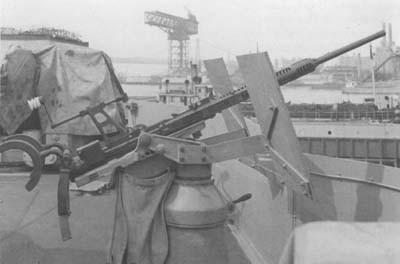
beauty of the loader standing at the side was that it was possible to mount the guns very close together as twins, with the loaders standing on the outside facing each other. This positioning made it possible to form a quad mount, with the pair of twins just far enough apart for the two inboard loaders to stand back to back. The US Navy went a step further by encasing the barrels in water jackets with circulating pumps, allowing the gun to fire forever. A runout valve in the hydraulic recoil cylinder controlled the rate of fire. The gunners mate simply increased or slowed the rate of runout by turning the valve with an ordinary screwdriver. Although a cyclic rate of 160 rpm per barrel has been reported, we usually held it down nearer to 120. Considering the devastating effect of even a single round, four barrels at 120 rpm threw a lot of stuff out there. I once compared the 20mm and the 40mm by firing them into an empty 100-gallon steel oil barrel, and the 40mm was perfectly devastating. No kamikaze could get past even a single quad-40 if its people knew what they were doing. I once told Commander R.H. Atkinson, Jr., gunnery officer of Idaho (BB 42), "I would take them for target practice if they don't come in too steep." I added the proviso because our ship had been close by two weeks earlier when Nevada (BB 36) had suffered severe casualties from a kamikaze overhead that they had taken to pieces in the air. If after more than 50 years my pronouncement to Commander Atkinson seems a bit "macho," it was made the day after my forward port sector and the marine sector on the port quarter had accounted for five kamikazes in just under four minutes, all by our 20mm and 40mm cannon except for one incredibly spectacular direct hit by our 5-inch 38-caliber gun. As the explosion of the 54-pound shell detonated the "Kate's" bomb, only a column of black smoke remained there, suspended motionless over the quiet sea.
With our 20mm and 40mm cannon, especially as the US Navy modified the 40mm, we had the world's best automatic weapons. But every hunter knows the best gun is no better than the aim of the man who fires it. Against rapidly moving aircraft, volume of fire alone, however desirable, is not enough. When the beginner fires at a covey of quail without aiming at a particular bird, it may seem that a lot of birds are out there. But he soon learns there is also a lot of sky. In World War II the US Navy took some very impressive movies of Japanese planes that kept coming, apparently unscathed, through what looked
--9--
like impossible clouds of tracers. There was a lot of sky out there too, so the question was, How do you get hits? Early on, gunners would aim tracers like a stream of water or use metal sights with concentric rings to achieve some sort of lead, or what the British called "aim off." But these efforts were unsatisfactory.
As it turned out, the US Navy had a secret weapon. His name was Dr. Charles Draper of MIT, creator of the Mark 14 sight and later other marvels. Like the guns it was meant to direct, the Mark 14 was about as simple and reliable as one could imagine. The greenest fire controlman third-class could take care of it, adjusting it to bore sight, changing reticles, or doing anything short of fooling with the two gyroscopes. The gimbal frame of one gyroscope held its rotation at right angles to movement up and down (elevation), while the other rotated around movement right and left (train). As an illuminated reticle followed a moving target, the precession (tilting) of the two gyros measured the target's angular velocity across the line of sight. Given the angular velocity of the target, the only other input required to calculate the necessary lead angle was time of flight of the projectile, which depended on range. A hand lever that moved a set of cantilever springs inside the sight controlled the range setting. Thus, like a diving board that becomes less flexible as one moves back toward its base, the cantilever springs, attached only at one end, become less springy as the lowered range handle moves their point of contact with the gimbal frames closer to their base. The lower the setting on the range handle, the less easily the range springs bend, the less the gyros are free to precess, and the smaller the lead angle as the target approaches. In practice, range setting was less important than it might seem, particularly within the ranges at which the 20s and 40s could be expected to have their main effectiveness, say inside 600-800 yards for the 20mm and 1000-1500 yards for the 40mm. The reason was that out to these ranges the trajectories were relatively flat. To the extent that the trajectory remained flat, little or no range adjustment was necessary for our head-on approaching targets. Add to this advantage the normal dispersion around the mean point of impact (mpi), and you had a barrier exceedingly difficult to penetrate.
The sight required power to illuminate the crosswire-shaped reticle and to control the viscosity of the damping fluid, which imparted stability to the entire inner mechanism. As the operator attempted to follow a moving target, the reticle, of course, tended to lag behind. This meant that he had to move ahead more rapidly, thus bringing the reticle up to the target and finally the gun ahead for the necessary lead. Many times I heard the plaint, "The reticle lags behind!" Repeatedly and patiently I had to explain, "That's the whole idea! If the reticle doesn't lag behind the gun, the gun won't be ahead of the reticle. Or, to put it the other way around, the gun must go ahead of the reticle if it is to point ahead of the target being held in the reticle." It may seem hard to believe that it was difficult to put over this simple idea, but it was not easy.
In extenuation, it must be admitted that the reticle was indeed a jumpy sort of thing. It seemed to bounce all around inside the eyepiece. And here was the secret: the Mark 14 sight had to move steadily and, above all, smoothly. Those two gyroscopes knew exactly what they were doing and they tried their best to respond to the directions they received. Given smooth and steady movement, they worked like a charm. Aboard a ship that was operating in company with aircraft carriers there was no problem at all. As planes flew about, my orders were always: "Dry-track. Dry-track. Dry-track. Get so that handling that Mark 14 sight is second nature." There may have been a few gripes at first, but I had always been a popular professor and I got along with these kids too. After the first (fortunately lone) kamikaze had been splashed close aboard Idaho's port side by the condition watch, I didn't even have to remind people. This was the Mark 14 sight mounted on the 20mm Oerlikon. Sperry Gyroscope produced a total of 85,000 of these sights during the war.
But the Mark 14 also controlled the 40mm Bofors. It was mounted on the Mark 51 director, a perfect combination. The Mark 51 was a simple handlebar arrangement with a backstrap for the operator. The gun mount followed the director's movements through a system of synchro motors. This remoteness from the gun mount eliminated the vibration that was
--10--
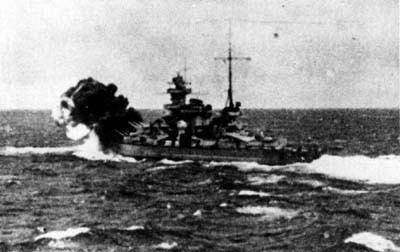
experienced when the sight was mounted directly on the Oerlikon. In firing tens of thousands of rounds, the vibration never bothered me, but I can understand that in the smoke of battle it may have been a distraction because under vibration the reticle tended to blur. The remoteness of the Mark 51 also avoided much of the smoke from a 40mm-quad.
With the station, personnel, and guns in place and with customers within five miles, we only needed something to shoot at. The US Naval Air Station (NAS) Bermuda was expected to tow sleeve targets for us, but this arrangement quickly proved to be unsatisfactory. Every day it seemed as if there was some reason why the plane from NAS Bermuda could not make it. But those fliers had another job: hunting German submarines. On 30 June 1942, for example, when US Navy submarine kills were scarce, Lieutenant Richard E. Schrader, USNR, of NAS Bermuda dropped a depth charge on U-158 that stuck to her deck grating as she submerged for the final time.
Our frustration did not last long. Captain Scott had chosen wisely. By this time Julian seemed to know everybody in both navies. The commanding officer of the Royal Naval Air Station was Commander George Fowler, who had been sent to Bermuda to recover from wounds received in December 1939 off the River Plate. On board the cruiser HMS Exeter, on which the German pocket battleship Graf Spee was concentrating her fire, George was climbing an exposed ladder when a hit splattered him with shrapnel. He had just two fliers in his Bermuda command. The senior was Ian McLaughlin, one of 46 survivors from the aircraft carrier HMS Glorious and her two destroyers that were intercepted by battleships Scharnhorst and Gneisenau as they returned from the Norway debacle without a heavy escort.
How a carrier with two destroyers could be surprised by battleships, when it should have been the other way around, is pretty hard to understand, but that was the way it happened. None of these ships had radar at that early stage of the war. Glorious had no reconnaissance planes aloft and nobody in her crow's nest. Ian told me that Scharnhorst's first salvo carried away the main radio antenna, preventing Glorious from reporting her predicament. Inexplicably, neither of the destroyers sent off a radio report. In any case, Ian survived for some days with his legs in the water. The damage to the blood vessels of his legs made him unfit for further carrier duty. Thus, like George, Ian was sent to the mild climate of Bermuda, also with his family. Their other flyer was Trevor David, a bearded, quick-witted sublieutenant, late of Oxford.
The Royal Naval Air Station was just looking for a steady job and the AATC filled the bill. The RN pilots never missed a day flying for any reason, and they never asked if we would soon be finished for the day. In December 1942, when we began doing some night firing at sleeves illuminated by searchlight (one of Julian's ideas), they handled that too, even while continuing to fly during the day. George and Allison Fowler had made a family of all his officers and their families, and we three lonely Americans were taken into the brood. We entertained them at Southlands, and they provided us a second home at their residence.
While Julian and Larry ran the show and dealt with the outside world, I (as senior instructor) concentrated on instruction and activities on the firing line. As a lifelong wing-shot, I became enamored of the Mark 14 sight and was soon an advocate. The sight needed an advocate at that point in the war because it tended to have a bad reputation among many old hands. Older gunner's mates would sometimes tell trainees to look around
--11--
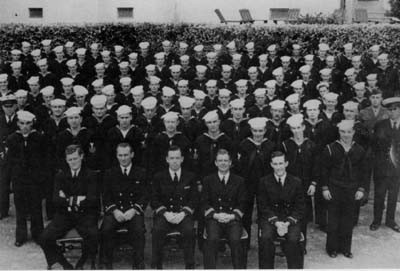
the sight and direct the tracers like a stream of water. This method was known as tracer control. What its advocates did not realize was that the human eye, with limited inter-pupillary space, could judge distance only to about 400 yards, beyond which all is optical illusion. As soon as I began firing it myself, the reason for the problem became clear. Firing-line instructors were gunner's mates. They felt their job was to teach the guns and to put the students through the firing line. The guns were not the problem. The students simply were firing before they were ready. I soon had students dry-tracking and learning to handle the reticle before actually firing. And just to show that the Mark 14 was not as bad as they might have heard, I often fired demonstration runs myself in those early months, sometimes on the 20mm and sometimes on the 40mm. I well recall an experience that indicated something of the nature of the problem. With Larry Springer setting range, I announced that we would fire three runs with a 40mm twin. However, when we shot the sleeves down on the first two runs and the flyer was stringing another sleeve, our chief came to me and said, "Mr. Wallace, I wish you and Mr. Springer wouldn't shoot anymore. We have to get these men to lunch."
I wrote mimeographed handouts on various subjects during my time in Bermuda, including a fairly thorough one on the Mark 14. I even received plaudits from the Sperry Gyroscope people on that one, and they sent a representative out to Bermuda to meet me. They were happy to find anyone with a kind word for their sight.
With all of the accelerated experience, our enlisted men matured rapidly, and we promoted them accordingly. We soon produced our own chief gunner's mate, and
Smitty proved to have fine leadership qualities. Julian, a perceptive administrator, realizing that in our informal atmosphere a steadily growing aggregation of green enlisted men needed some organization, got Admiral James to lend us a Marine sergeant. Sergeant Leady, a mature, personable man with a talent for leadership, quickly turned out a happy, orderly crew. I was particularly impressed because he could hit about anything he shot at with a Colt .45 automatic.
In the early stages of our operation when trainees were scarce, Julian, the consummate PR man, also sold Admiral James on the idea that all Navy officers should be introduced to the antiaircraft problem. As a result, all of the junior officers at the base were scheduled for three days of training at Southlands. Bermuda was a quiet base and gunnery was glamorous, so our program became
--12--
immensely popular. Even some of the supply officers managed to get in on it. The Royal Navy also had an antiaircraft training center in Bermuda, but it possessed meager resources. We did all we could to help them. An enthusiastic Britisher who visited often was Captain Paul A. Curtis, for several years the celebrated gun editor of Field and Stream magazine. Paul was training snipers and was a deadly shot with any weapon. Needless to say, "gun-nuts" were attracted to the AATCs like flies to sugar—the Oerlikon, the Bofors, and the Mark 14 providing the great attraction.
Our first big surge of students came from landing craft on their way to Operation TORCH in North Africa. When one of their officers complained that his men could not get their 20mm to work, I sent a gunner's mate back to his ship with him that evening. It turned out that they had never removed the Cosmoline! Apparently we were all learning by doing. During my teaching days, as the war clouds were clearly gathering in 1938, I had begun telling my students that someday we would meet again in strange and far away places. Now it was beginning to occur. On one of the landing craft was a young officer, a former student of mine from Park College in Parkville, Missouri, where I had taught from 1937 to 1942. Most of my students had joined the armed services, the majority as naval officers. In fact, Joe Scoggin, one of my protégés both before and after the war, was called away from his doctoral studies for active duty in the Korean War. Joe stayed on to become a rear admiral in charge of the Navy's worldwide merchandising activities.
When I heard rumors of Free French ships and asked one of Admiral James' aides if we should be getting ready for such an eventuality, he replied, "Speed of a deer!" We soon spotted on a landing craft a bilingual down-Mainer who quickly recognized the advantages of our station and agreed to become an instructor. When the French crews arrived, there was occasional merriment over his accent, but he knew how to handle it and proved to be a fine addition to our crew. But this was early in the war when everything was expanding.
In mid-May 1943, after just seven months on the job, Julian was transferred to Northwest Africa where he was "scheduled to set up a new AATC," according to the COTCLANT newsletter of June 1943. The same source reported other changes. Lieutenant Gus T. Greanias, USNR, from Dam Neck took over command at Price's Neck, while E. C. Spencer left there to become antiaircraft gunnery officer of the newly commissioned battleship New Jersey (BB 62). Ed Spencer was the first of the many of us from the AATCs who eventually were sent to a "large combatant vessel," as my own orders later read. Larry Springer was sent to Long Island, New York, as commanding officer of a new AATC there. Later Larry went to the antiaircraft battery of the carrier Randolph (CV 15), where some of us visited him at Ulithi.
Julian's relief at Bermuda was Lieutenant Edwin A. Hills II, USNR, and, aside from the British, the first truly salty character at our station. Ed was born within sight and smell of salt water at Hingham, Massachusetts. He had been yacht racing to Bermuda since he was a teenager, and the old families there on the island had him out to dinner as soon as they learned that he was in town. As a Harvard ROTC graduate, he had been called up in April 1940 and had spent a year on board the light cruiser Savannah (CL 42). We now had a skipper who knew something about the real Navy. Up to that time we had all been doing our own thing, more or less. The new executive officer replacing Larry was Bill Pollock, also capable and personable. Another fine officer who joined us soon after Ed Hills' arrival was Jim Cronin, a New York lawyer who quickly developed an interest in the guns and got along well with the men. We also got an instructor for aircraft recognition, an Ensign Hendrix from Tennessee.
In mid 1943, shortly after Ed Hills' arrival, the Destroyer and Destroyer Escort Shakedown Group, under Captain James L. Holloway, Jr., came to Bermuda. This huge organization quickly became the chief source of our trainees. Some destroyer escorts had a 3-inch 50-caliber main battery and some had a 5-inch 38-caliber. To expand our firing space for them, an entire hillside had to be excavated. Everything ran smoothly, as always, and our warm friends, the British, continued to supply all of our target needs.
--13--
Price's Neck
Meanwhile back at Price's Neck, Gus Greanias, who had taken over the command when Ed Spencer went to New Jersey, received a huge assignment. With the gestation periods of substantial numbers of major warships about to end, Admiral Donald Beary, the recently appointed Commander Fleet Operational Training Command, Atlantic Fleet, had to figure out how to man them with personnel not likely to run them aground. You could not send a new aircraft carrier or battleship out with a bunch of green kids. From January to June 1944, he had to have crews ready to go on board two Iower-class battleships, an Alaska-class large cruiser, and three Essex-class aircraft carriers, with four more of the Essex-class scheduled to come out monthly from August through November. The only solution was to train the crews before they ever saw their ships.
The Naval Training Station (NTS) at Newport (boot camp) afforded the necessary ample berthing space and an AATC nearby at the mouth of Narragansett Bay. At NTS, the equipment that crews would find on board ship was set up ashore: engine rooms, guns and directors of all kinds, kitchens, radar and radio, fire-fighting equipment, and everything else. The trainees would be bussed out to Price's Neck for actual antiaircraft firing. Gus's work was cut out for him. But he was a sharp-eyed administrator, having served as executive officer under Commander P. D. Gallery at Dam Neck. He told me later that he had plenty of officers but nobody really interested in the guns. He had only to step out of his office to see that the shooting was all over the sky. So Commander Gallery was called upon to look among the AATCs and try to find somebody. He came down to Bermuda in early January 1944, and I showed him around our firing line. He said that if we had any handout material, he would like to have copies and spoke glowingly of one he had read somewhere on the subject of the Mark 14 sight. It was late in the day when I gave him copies of our material, and he took them upstairs with him to lie down a few minutes before dinner. He had been traveling much of the day and he was tired. As he came down the stairs a little later, he was grinning. He said to me, "When I praised that paper on the Mark 14 sight, I didn't realize that you were the one who wrote it." Commander Gallery left the next morning, and on 11 January a SPEEDLETTER arrived from BUPERS transferring me from Bermuda to Price's Neck with no delay en route.
I was already familiar with Price's Neck and Newport, and Gus was easy to work for. He gave me a completely free hand. The problem was about as simple as could be. It all boiled down to, "Dry-track until you have that sight in hand." The enlisted instructors, as always, were conscientious, competent, and experienced. I got them to do some shooting themselves, which most of them had not done. It didn't take them long to see the difference. The training took longer but the results were obvious. One day Gus stood out watching some firing runs. He said, "I have just made out your Fitness Report. The shooting is 100 percent better since you came, but I only gave you a 3.9. I want to allow some room for improvement."
Everybody at Price's Neck was easy to work with. The other officers ran the station and handled the tower and communication with the towing planes, while I concentrated on the firing line. I guess we needed only one "gun-nut." Gus later commented, "Dam Neck was labeled a test center, but it never had the volume of trainees or the facilities to house and feed the students for periods of intensive instruction. P.N. [Price's Neck] furnished the officers for the new AATCs, enlisted men too, plus 10% a month turnover of instructors to fleet assignments."
Aware of the huge amount of firing at Price's Neck, BUORD occasionally sent us equipment to subject to "accelerated depreciation," in other words, a lot of shooting. When feasible I did the testing and wrote the report myself. I was on the firing line all day anyway, and I enjoyed the shooting and the report writing as well. I remember that once they sent a twin 20mm mount and an experimental lead-computing sight at the same time. The sight—the Mark 20—was a product of General Electric, as I recall. I had it mounted on the 20mm twin; an arrangement that would surely afford significant "accelerated depreciation." During several afternoons I fired literally thousands of rounds at sleeves and had great fun.
--14--
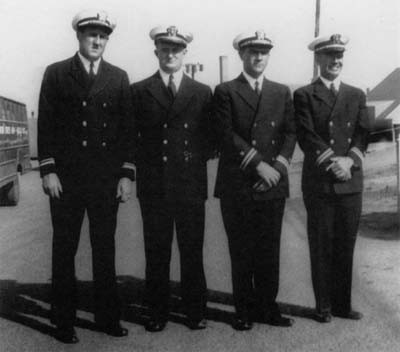
The sight showed no sign of "depreciation," but I did. The intense vibration caused a noticeable numbness in my left arm that extended all the way out to my index finger and lasted for a couple of days. The sight was half the size of the Mark 14, and I gave it a favorable report, but I never heard of it again. The war was well advanced by then, and the wholly satisfactory Mark 14 was in place throughout the fleet. Moreover, there was really no need for a 20mm twin. We needed every quad-40 we could fit in. I remember once counting something like two-dozen quads on Saratoga (CV 3).
But Gus and I both wanted to get to the Pacific. We were afraid the fighting might be over before we got there. Considering our subsequent adventures, we need not have worried. We kept expressing this view to Admiral Beary's friendly liaison officer, a survivor of the cruiser Astoria (CA 34), whose legs were black with shrapnel wounds. The admiral's message was that we would get our wish, but we needed to finish this job first. He was as good as his word. After some months, Gus was sent to the heavy cruiser Pittsburgh (CA 72), commissioned in October. His relief was Ralph Connor, a fine man who had to be transferred from the battleship California's (BB 44) antiaircraft battery when he developed a slight heart problem.
I had to stay on for four more weeks to supervise firing on the attack transport Dauphin (APA 97), which embarked precommissioning trainees twice weekly for three-day stints to give them experience of actually firing at sea. My orders explained that since Dauphin "will report shortly after shakedown, [COTCLANT] considers that her gunnery officer is not yet sufficiently qualified to undertake underway gunnery instruction." What the captain told me when I reported aboard on 31 October was that he had made the request because he was afraid that the trainees might shoot off the topside of his ship. He need not have worried. His gunnery officer was a competent, well-qualified man. Together we worked out the program, which ran smoothly. Just before I went to Dauphin, I met another old friend. Eldon Sloan, from my hometown and a fraternity brother at the university, came through as a trainee from the
--15--
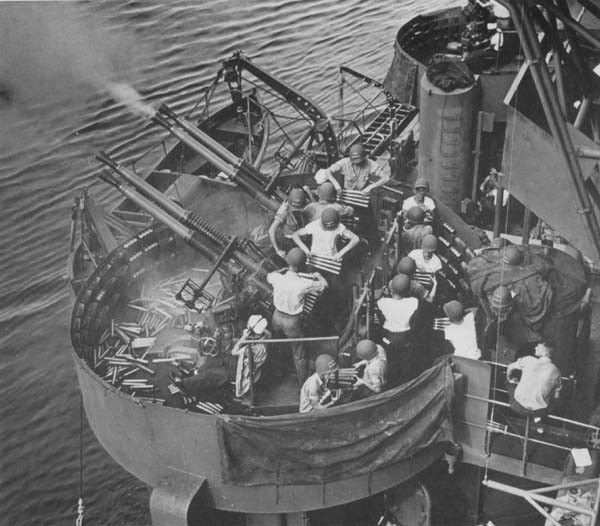
attack transport Shoshone (AKA 65), which I saw later at Iwo Jima.
At about that time, Admiral Beary's liaison officer told me I could now formally request sea duty. I asked for duty in the Pacific on board a battleship or cruiser. In Ralph Connor's first endorsement he wrote, "Forwarded strongly recommending approval," and adding gratuitously, "Lieutenant Wallace's thorough knowledge of antiaircraft gunnery should prove to be of greatest value to a Capital ship," an assessment with which I tended to agree. The second endorsement from COTCLANT recommended that my detachment be ordered after completion of the Dauphin assignment and "further recommended" an "A.A. gunnery billet aboard a large combatant vessel."
When the COTCLANT endorsement came through promptly, I asked Ralph, "Don't you think I should take a 72-hour leave and go to Washington? 'Large
--16--
combatant vessel' could mean anything." I hurried down to Washington and went directly to the officer in BUPERS who was handling assignments. I was lucky. He was alone and there was time to talk. He said to me, "Oh, yes, Lieutenant Wallace. I was just going to send you to an operating Essex-class carrier." I told him all of the carrier gunnery officers agreed on one thing: "Stay off the carriers. Their interest is in the fliers. Your gun crews will just become working parties." Then I asked, "How about a cruiser?" The answer was, "You are too senior for a cruiser. How about a battleship?" I said that would be great, and so it was settled. Now so many years later, I am a bit amazed by my own presumption, but I guess I was still innocent in the ways of the Navy. Actually, I think my attitude was formed by experience in the informal Navy AATC organization where any reasonable and logical proposal received a sympathetic hearing from a superior officer without resort to rank or seniority. All of my contacts had been with such people—Captain Scott at COMINCH; Julian Eysmans, Ed Hills, and Captain Holloway in Bermuda; P. D. Gallery at Dam Neck; and Ed Spencer, Gus Greanias, Ralph Conner, and Admiral Beary's liaison officer at Price's Neck. All were exceptionally competent and reasonable men, and all would have stood out in any organization.
My Washington trip had an epilogue that would grab the attention at any Navy fireside conversation. My orders soon came through for Idaho, to which I reported on Christmas Day 1944 in Bremerton. There were two operating Essex-class carriers there and two battleships, all ready for return to the Pacific. The two carriers were Franklin (CV 13) and Bunker Hill (CV 17), by far the two worst damaged carriers of the much-battered Essex-class at the end of the war. The other battleship was Tennessee (BB 43). Of the capital ships gathered at Bremerton that morning, Idaho would turn out to be the only ship of the four whose people received no serious injuries. Tennessee would suffer heavy casualties from a kamikaze crash dive on 12 April 1945 at Okinawa. Ironically, this was during the same raid and at exactly the same time (1450) when Idaho knocked down the five kamikazes that I had in mind when I made my ill-considered boast about welcoming them for target practice. But for my Washington trip I would have been on board either Franklin or Bunker Hill.
A "Large Combatant Vessel"
This opened a new chapter in my antiaircraft story, but now the theory and target shooting would be put to the test of battle. In Idaho I was designated automatic weapons officer. I was also put in charge of the 8th Division, responsible for the forward port sector, which I would control in battle from my station in Sky Control, the central AA position. With the 8th Division and its gun crews, I quickly developed the relationship I had enjoyed with the AATC crews and with several generations of college students before that. A division officer is disciplinarian, protector, father confessor, and overall boss to his men. This relationship more or less defined and limited the relationship of the automatic weapons officer to the men of other divisions. In Idaho he was responsible for the upkeep and general maintenance of the equipment, but I quickly recognized that the other division officers would have been very sensitive to any interference from one perceived as simply another division officer. I could and did check equipment, especially Mark 14 sights and Mark 51 directors, but it would have been unwise to command or even recommend to the men that they practice dry-tracking; though, of course, I rec-
--17--
ommended it to the two division officers on the starboard side.
My situation was made even more sensitive by the fact that I was new to sea duty and to Idaho, while most of the officers had been on board for years, in some cases virtually their entire active-duty service. The one group about which there was never any question was the Marine detachment, located just abaft of us on the port quarter. Like true Marines, and like my own men, they were drilled to the Nth degree. The Marines were the only ones who had officers actually firing guns in battle. Marine Lieutenants B. W. "Duly" Dulany and W. E. "Bill" Greenip, Jr., pointed Mark 51 directors at General Quarters. Duly and I shared most of our condition watches in Sky Control during a period of eight months. We became great friends. He was fully familiar with our dry-tracking and, like me, very experienced in actual firing, as indeed was Bill Greenip. Our ship was attacked by a total of seven kamikazes and luckily, in my view, all but one of these came in on the port side.
I soon found a need for the automatic weapons officer role. I discovered that Idaho, in spite of a general upkeep at Bremerton, had not replaced the old crosswire reticles in the Mark 14 sights. After receiving numerous complaints about the tendency of the illuminated crosswire to smear and to blur under vibration, the Bureau of Ordnance acknowledged the fact, known to every rifleman who has used an aperture peep sight, that one of the things the human eye does naturally is to center a circle,
even if it seems quite large. So in 1944 BUORD authorized a modification for the Mark 14 sight, providing a large illuminated circular reticle. Idaho never seemed to stop anywhere long enough to get the replacement reticles through regular channels, forcing me back into the informal mode of my AATC days. At Pearl Harbor I walked into the main supply office near the end of the day before we sailed for Iwo Jima and walked out
The Marines were
the only ones who
had officers actually
firing guns in battle.
a few minutes later with my pockets full of circular reticles. Our Mark 14 sights would now have aperture reticles. I think perhaps the main lesson is the old one: proximity to the battle area tends to expedite matters.
At Iwo Jima, along with several other battleships, we provided bombardment support. Air attacks there were relatively light, probably because the fast carrier forces were hitting the Tokyo area with the express purpose of minimizing such attacks. The most serious one occurred two days after the 19 February D-day, when Saratoga was severely damaged by five kamikazes and the escort carrier Bismarck Sea (CVE 95) was sunk. We saw no Japanese aircraft at Iwo Jima during daylight, although the day before the landings, just after dark, we observed an enormous volume of antiaircraft fire as the ships near the beach suffered a small raid. Moving well off to the east in our ship's "night retirement," all of us in Sky Control looked at each other in amazement and relief, happy to be far out from under so much "friendly fire." Interestingly enough, the only effective antiaircraft fire we observed at Iwo was Japanese. On 17 February, while flying as a spotter for Idaho's gunfire, Marine Lieutenant M. L. Connally was painfully wounded when a 25mm AA shell penetrated the cockpit where he sat. Blood was streaming from the hole in the side of the plane as it taxied to the ship. As it turned out, the wound did not prove to be serious, though indeed it was a near-miss.
The other Japanese hit was on a flight of B-24s the morning of D-day while they were flying at less than 1,000 feet, sensationally low for these high-altitude planes. As the formation passed over the island, the Japanese responded with heavy automatic weapons fire and hit at least one of them, knocking off a large, heavy fragment that could be seen falling to earth.
Although we suffered no air attacks at Iwo Jima and were never challenged by shore batteries, we did have a couple of hair-raising experiences. Just how hair-raising one of them would have been had we known the central fact, I learned only 15 years later while reading Samuel Eliot Morison's
--18--
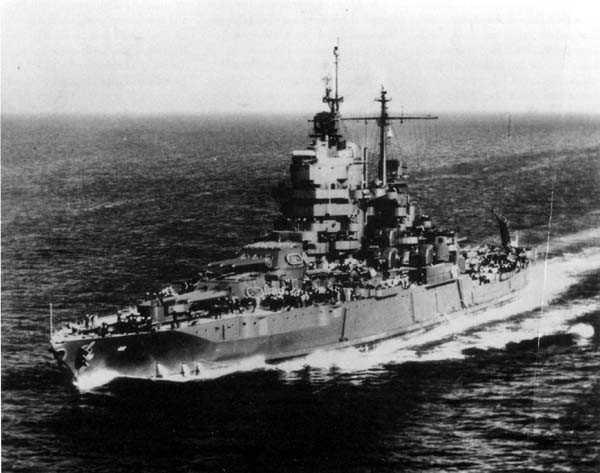
account of the Iwo Jima operation. While sitting in Sky Control with Lieutenant Dulany, I remarked, "Duly, they are shooting at that ship." This ship was at anchor between us and the island. It was just a short distance away, and we could clearly see shell splashes approaching her. The gun was well short at first but kept getting closer, until a shell landed just off the fantail, close enough to wound one of the crew, as Morison reported later. But the Japanese spotting officer made a mistake. Instead of first getting in line with his target to see whether his shell splashes were between him and the ship or beyond it, he apparently just assumed that he was "over" and began "down spotting," with his splashes falling farther and farther short.
Meanwhile the ship got underway, while battleship Mississippi (BB 41), as I recall, took the battery under fire, and a destroyer went racing in like an angry watchdog, her 5-inch 38s barking in rapid fire. The chilling fact of which I, at least, was unaware at the time was that the lucky target was the ammunition ship Columbia Victory, whose detonation would have been a disaster for nearby ships as well. Another close call came when one or more battle-
--19--
ship shells exploded near enough to Idaho to scatter huge pieces of shrapnel on the decks. One of our men showed me a fragment so heavy that he had to hold it up with both hands. We were on the east side of Iwo at the time, and the shell or shells came from a ship on the west side, which obviously was shooting too high. The very loud sound of "whoo-whoo-whoo," heard before impact, suggests that the shell could have been a ricochet.
As Morison points out, the great beneficiary of the Iwo Jima operation was the Army Air Forces. Lying as it does on the route to Japan from the B-29s main base on Saipan, Iwo afforded a safe haven for planes that were damaged or low on fuel. It was estimated later that by war's end some 2,400 B-29s had landed there. Its proximity to Japan also made it possible for Iwo-based P-51 fighters to provide escort for the huge bombers. The first distressed B-29 to use the island came in amidst the heavy smoke of battle. My impression of its arrival, as I expressed it to Duly there in Sky Control, was that it was like a hungry predator beginning to feed on a victim that was not yet quite dead. Idaho sailed from Iwo Jima on 7 March, and all of the heavy bombardment ships were gone by the 12th.
After Iwo Jima, we headed to Ulithi Atoll in the Carolines to prepare for the Okinawa opera-
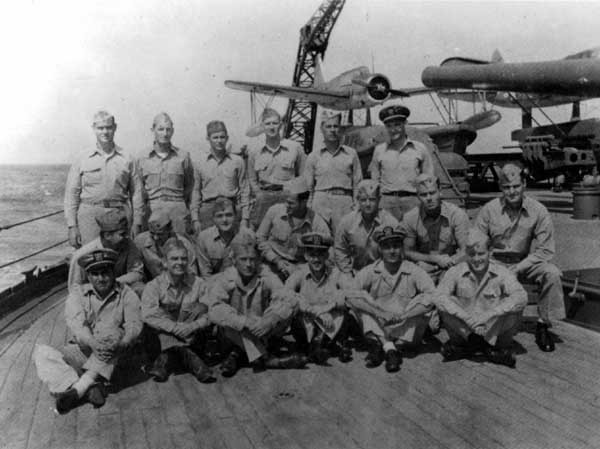
--20--
tion, arriving on 10 March. It proved to be a gathering of the clans in more ways than one. Everybody was there. Even the British arrived with battleships, carriers, and destroyers. But the gathering that was especially exciting to the old AATC gang was that of our buddies. Everybody I knew who had been enthusiastic about our AATC work had requested sea duty and, as Gus and I had, each had by now been sent to a "large combatant vessel" for duty. From the Bermuda crew, Ed Hills was in South Dakota (BB 57), Jim Cronin in Washington (BB 56), and Larry Springer in Randolph. From the Dam Neck—Price's Neck people, P. D. Gallery commanded his own destroyer, Ed Spencer had long since gone to New Jersey, and Gus was there in Pittsburgh. These officers were just the ones from the stations we knew about. No doubt there were other officers present, some from the many other AATCs. Of course, the AATCs had also provided the fleet with many experienced gunner's mates.
Ulithi was a secure, faraway haven, or so it seemed, and all was relaxed. On the evening of the 11th from the heights of Sky Control where, as a navy buff, I climbed just to enjoy the sights, the lights of great warships stretched out as far as the horizon. It was an awesome spectacle, one to stir even the most unimaginative soul. A bit later that evening, to a young Japanese flyer it must have seemed awesome at first, the great dome of light in the skies over Ulithi, and then the vast sea of brilliantly lighted ships spread out before his gaze. He had come a long way, his navigation impeccable. And he was unexpected. But he had bad luck in his approach to the target he chose, Larry Springer's carrier Randolph. Although great numbers of men were gathered to watch a movie, he crashed toward the rear of the flight deck where there were very few people and relatively little he could damage. While the ensuing explosion was spectacular, it was soon extinguished. When I went on board the next day to check on Larry, the damage was not easy to see. Years later Gus Greanias wrote me, "You mention the Randolph at Ulithi, I was there visiting Larry Springer and some Dam Neckers when the kamikaze hit. We were at a movie and they never called general quarters." But it was a warning of Japanese resolve and a harbinger of events at Okinawa.
After this flurry of excitement things quieted down, and I found time to visit both Ed Hills and Jim Cronin. On board South Dakota, Ed showed me where an armor-piercing shell from the Japanese battleship Kirishima had skidded across the deck and cracked the barbette of a main battery turret during the climactic naval action at Guadalcanal on the night of 14—15 November 1942. This hit occurred short minutes before Washington, lying off unobserved in the darkness, destroyed Kirishima with something like 75 rounds from her 6-inch main battery fired at point-blank range. Jim Cronin had always shown a great deal of concern for the welfare of his men, and the strongest impression of my short visit with him on board Washington was of his distress in showing me where an errant 20mm shell had killed one of his men in what we now call a friendly fire incident.
During the 10 days that we spent at Ulithi, I had an experience that demonstrated the degree of fine-tuning the Navy had achieved by then. Facing the Okinawa operation, our ship's automatic weapons complement suffered a serious breakdown. The failure of a small fibre gear, probably no more than six inches in diameter, rendered a 40mm-quad mount inoperative. In all of our millions of rounds of firing at the AATCs I had never seen this breakage before, nor indeed any failure at all in the servo system that linked our mounts to the Mark 51 directors. With the stripped gear in hand, I headed for the barges of Service Squadron 10, with little hope of finding this obscure part. But I need not have worried. At SERVRON 10, in one of those delightful encounters with an old friend, I met one of our Bermuda supply officers who had taken the three-day course at Southlands. He soon produced the necessary gear and even gave me a spare. That experience was typical of my entire Navy career. People were competent and dependable and everything seemed to work out as planned. But, of course, I was not out there during some of the early operations when there was still much to be learned. The ship was not idle during our stay at Ulithi. In addition to all the necessary upkeep we had two days of antiaircraft firing practice.
--21--
Destination Okinawa
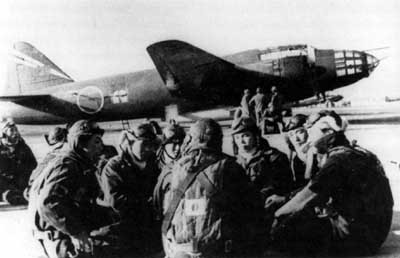
Admiral Marc Mitscher's fast carriers of Task Force 58, with their battleship escorts, left Ulithi on 14 March and got into trouble almost immediately. Three carriers received only minor damage on the 18th, but the next morning Wasp (CV 18) was damaged rather severely and Franklin was devastated, mainly by explosion of her own ordnance. When Franklin's engines failed, Pittsburgh took her in tow for two days until she could move under her own power. She lost 724 killed and 265 wounded in the attack. Succoring her people was a sad and bloody business. Gus told me that even now, more than half a century later, he still cannot stand the sight of a rare steak.
These misfortunes could not be attributed to the failure of antiaircraft protection. The problem here was detection. The successful attacks against both Wasp and Franklin were radar (and perhaps lookout) failures. In each case, a single bomb from a horizontal bomber that had arrived undetected overhead hit the ship. It is difficult to understand how this could happen, especially in view of the large number of battleships, cruisers, and destroyers surrounding the carriers for no other purpose than to protect them. Apparently, the surprise element of the attacks on both the 18th and 19th raised doubts about the efficiency of the radar itself.
In fact, as ensuing experience in the Okinawa operation demonstrated, American radar did have shortcomings. Part of the problem was lack of accurate height-finding capability and another was frequent loss of contact as an approaching raid drew near. These were relatively small raids that were more likely to escape detection. There was no difficulty three days later on the 21st when radar detected an approaching raid 100 miles out. But this was a large force of 48 planes, including 18 "Bettys," each carrying a human-guided rocket ("Baka" bomb) slung under its belly. These suicide rockets carried a 2,600-pound warhead and were so fast as to be almost impossible to intercept once they were launched from the mother aircraft. In this case, all of the "Bettys" were destroyed before they could launch their charges. In any case, radar or no radar, the frequency of surprise attacks on carriers raises the question of lookout efficiency. These kids all had the keenest of eyesight and often amazed me by their ability to detect distant objects. The fact that there were literally hundreds of people on watch in the force, with no other duty than to detect enemy aircraft, does raise a question of alertness. In the case of Franklin, there was the mitigating circumstance that she was in the midst of launching her own planes, making it difficult to distinguish a bogey from her own aircraft. It was my strong impression though that many ships did not seriously drill their people in aircraft recognition.
We got underway for Okinawa on the 21st as part of Task Force 54, the Gunfire and Covering Force for the coming operation, and had a thorough antiaircraft firing exercise that afternoon. Moving out for a new invasion was always exhilarating, and we knew this was going to be a big one. That night, on watch in Sky Control, we had an interesting scene on our PPI (Plan Position Indicator) radarscope. As the name
--22--
implies, it was like an illuminated map of the area surrounding the ship. A rotating pointer, similar to a clock hand, painted in the objects (pips or blobs) recorded by the radar antenna rotating above. The pointer and the face of the scope were illuminated in a green light, similar to the green lights on a car dashboard. The features recorded by the radar and painted in by the pointing arm appeared as dark blobs indicating islands, headlands, ships, or indeed any object substantial enough to bounce back a radar signal. The image on the screen that night was the cruising formation of all ships in the Covering Force, heading for bombardment duties. Although a disciplined group of warships traveling together will always hold to designated positions, this formation was something special. The protecting destroyers of the screen formed a perfect circle, while the heavy bombardment ships inside the circle formed a perfect star.
Except for occasional alarms, the passage to Okinawa was relatively uneventful, but the morning of our arrival on 26 March foreshadowed coming events. Just before daylight, as I reached Sky Control for our daily exercise of dawn general quarters (battle stations), I could see three or four huge gasoline fires on the surrounding sea, falling gradually behind the formation as we moved ahead. I asked, "What are the fires?" The answer was, "The screen has just shot down a bunch of bogies." I then asked, "Why didn't we go to general quarters?"
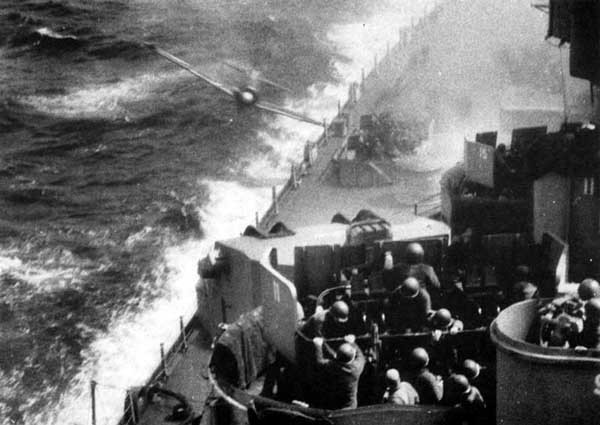
--23--
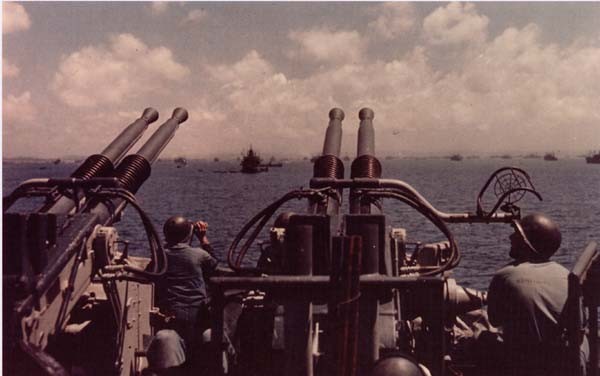
The answer was, "The captain didn't want to disturb the men because this is going to be a busy day." Never again at Okinawa would we take such a relaxed attitude toward Japanese aircraft.
This exciting episode was our introduction to the battlefield performance of America's latest miracle weapon, the VT (variable time) fuse, also (and more meaningfully) called the "influence" or "proximity" fuse. For larger caliber antiaircraft guns like the 5-inch/38, which seeks to destroy a plane with shrapnel by exploding a shell near the target, the VT fuse eliminated what was by far the greatest difficulty—getting the shell to explode at just the right time— neither too soon before reaching the target, nor too late after passing it. Ordinary fuses were preset at the gun and then loaded into the gun by human hands. The biggest, strongest man was always chosen to lift the 54-pound shell and place it on the loading tray of the gun. I have seen an officer with a stopwatch seeking to establish the exact time interval between setting the fuse and loading the shell. Each loader took a different time and, indeed, could not be expected to be consistent each time. Where timing was everything, room for error was monumental.
With the help of radar it was no great trick for our Mark 33 director to compute the lead angle and range necessary to place a shell in proximity with a plane (after all, the word RADAR is simply an acronym for "radio direction and ranging"). And it can do this in complete darkness, as those unfortunate Japanese fliers learned that early morning of 26 March 1945. The principle of this radar fuse was simplicity itself. From its location in the nose of the shell, it bounced its radio waves off the target. When these signals became strong enough to indicate an object within lethal distance, it more or less announced that fact by exploding
--24--
the shell. Although the principle was simple, developing miniature radars with tubes rugged enough to withstand the shock of firing the shell was a daunting problem. But somehow it was solved, and the VT fuse became our secret weapon.
In ground warfare, exploding the shell a few feet above the earth reduced or eliminated the relative safety that the foxhole had afforded the infantry. Because of the fear that a dud VT-fuse-equipped shell might fall into German hands, it was not used in Europe until the emergency during the Battle of the Bulge. Thus "smart shells" antedated our recently much publicized "smart bombs" by nearly half a century. In firing at aircraft, a 5-inch 38-caliber gun did not fire all VT fuses but instead mixed them in with ordinary antiaircraft common (AAC) on which the fuses were preset at the guns. These shells would all explode, thus performing more or less as tracers. By observing the bursts of the preset fuses the director operator could tell where his shells were going relative to the target. Wherever the bursts were moving, he knew that his deadly VT fuses were among them and he could make appropriate corrections, somewhat in the manner of "spotting" surface fire.
In night engagements, this pattern of mixing VT with AAC afforded one of the most dramatic spectacles in warfare. Since doctrine called for bombardment ships of the Covering Force to remain quiet under most circumstances, and hopefully unnoticed, while the screen protected them, we had ample opportunity to observe the destroyers' 5-inch fire when snoopers came around at night. For the snoopers it was not a healthy business. When a destroyer began firing at a bogey in the darkness, an observer could readily follow the path of the aircraft and the progress of the action by the clearly visible movement of red bursts across the night sky. As the shells burst, each one ahead of another, I always had the impression of a man rapidly reaching and reaching, with first one hand and then the other, for an object just beyond his grasp. But the red bursts did not last long before ending in a huge ball of orange flame, as shrapnel found the aircraft's gas tanks. Rarely did the unfortunate fliers escape. I have always believed that U.S. Navy destroyers were the best shots in the business, especially against aircraft. By the time of Okinawa, enemy planes were their main targets, and of course they
had plenty of practice. After all, the 5-inch was their main battery. Destroyer skippers tended to be bold, freewheeling spirits with confidence in themselves, a trait fully justified by their legendary performance, especially when their ships were operating in the radar picket line off Okinawa.
With the certainty of an extended large-scale presence at Okinawa, the Navy needed a secure base for refueling, ammunition replenishment, and repair of damaged ships, instead of having to do these tasks in the open ocean. Through the foresight of Vice Admiral Richmond Kelly Turner, our amphibious commander who disregarded much counsel against it, we seized the Kerama Retto, a tight group of islands only 15 miles to the west. Before the attack began on Okinawa itself, we occupied this group in a largely bloodless operation in
--25--
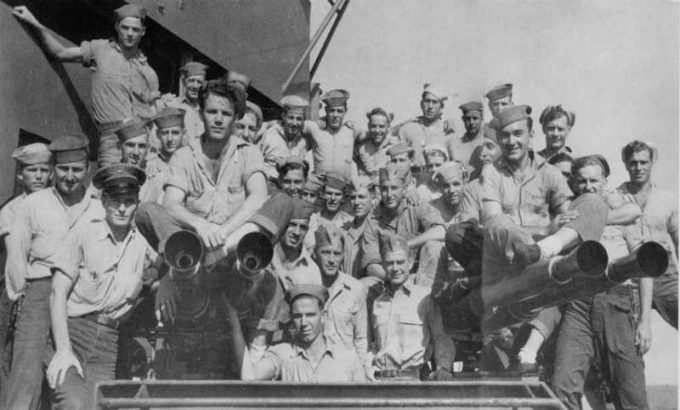
which Idaho participated only briefly, since no big guns proved necessary. Somehow the usually farsighted enemy had arranged for only the lightest defense. The main roadstead was capable of holding 75 large ships, with both entrances closed by steel nets. The kamikazes made a few small, partially successful attacks on Kerama Retto, but basically it was a tough place to approach, with its excellently sited radar and antiaircraft guns on the surrounding hills. Through the long Okinawa campaign, we retired to the anchorage for bullets, fuel, repairs, and mail. On board Tennessee, which like Idaho was there often, Admiral Morison recalled, "Inside the roadstead despite frequent air alerts, one had a feeling of security, like having a roof over your head in an air raid. . . . For that boon alone, sailors blessed Kelly Turner, whose bright thought made it possible." On the radio network throughout the campaign, Kerama Retto's witty and appropriate designation was "Wiseman's Cove."
After our arrival at Okinawa on 26 March, we did not have long to wait for antiaircraft action of our own. The next morning enemy aircraft were reported an hour before any reached our vicinity. Then at 0620, shortly before sunrise, a twin-engine "Frances" made the mistake of flying past Idaho after
--26--
dropping a bomb that did not score. At a range of 5,800 yards, our 5-inch turrets opened fire. It was about as auspicious an introduction as anyone could have hoped for. With five guns firing together, the plane burst into flames almost immediately. I would guess that she was destroyed by the very first salvo. But other salvos were already on their way when the hit was observed, and it took a bit of time for the guns to get the cease-firing order. The entire firing lasted but 15 seconds with a total of 20 rounds expended—only one a VT. The performance was perfect, and if the VT exploded, it was not needed. The aircraft was smothered by the shells bursting around it. This was the only time in Idaho that I ever heard cheers at an enemy's discomfiture. Almost immediately the scene became too grim for such shallow emotions.
Within two minutes, our 5-inch fired 21 rounds at a "Val" which was making a suicide run on Nevada, but we claimed only an "assist." Although this plane was shot to pieces by Nevada's automatic weapons, it was in such a steep dive that it crashed in flames on the quarterdeck, killing 11 men and wounding 49. Within another 10 minutes, the 5-inch battery fired 39 rounds, when "four or five enemy planes [were] splashed by ships of [the] disposition." But again we claimed only an "assist."
The organization and battle stations of the antiaircraft officers were determined by the nature of the problem. The 5-inch battery had two directors, which limited it to two targets at any one time. Hence it needed only two officers to direct it, both of whom were located in Sky Control. This arrangement enabled the battery to engage targets on both port and starboard sides at the same time or to split between two targets coming in on one side. One of these officers was our boss, Lieutenant Commander G. J. Bishop, the antiaircraft officer and assistant gunnery officer. He was a very friendly, able, and conscientious Mississippian nicknamed Bish. Although he was the antiaircraft officer, Idaho's mission was bombardment, and he was usually engaged in directing that activity more or less both day and night. No man on the ship worked harder. When Bish came to Idaho, it was his first sea duty, and he had served in the ship for nearly three years before I joined her. This situation was a common one— Commander R. H. Atkinson, Jr., the gunnery officer, a former CCC officer, had come to Idaho on his first sea duty nearly six years earlier. The other 5-inch officer, Lieutenant Ernest J. Marx, USNR, was a warmhearted, highly intelligent young man from St. Louis who joined us at Ulithi before the Okinawa operation, having had more than three years of sea duty.
Unlike the 5-inch battery— limited to two targets by two directors—the automatic weapons represented several dozen independent units, each capable of
--27--
engaging a different target. Hence the ship was divided into four sectors, each controlled by a sector officer. But after firing began, each 40mm and each 20mm operator was on his own and thus was afforded an opportunity to exercise individual initiative. In my sector, in at least one instance, this kind of initiative resulted in the destruction of a passing kamikaze that otherwise might have crashed into one of our accompanying ships, or even our own.
The sector control officer on the starboard side behind me was Lieutenant Fred J. Corales, USNR, of Louisiana who had come to Idaho on his first Navy duty nearly two years before. Freddie was pleasant and friendly enough, but we had no contact except back to back on opposite sides of Sky Control during general quarters, and I never really got to know him well. Freddie, like me, was also a division officer—in his case the 7th.
The two sector officers aft were Captain Robert H. Daley, commanding officer of our Marine detachment, which handled the port sector, and the 5th Division officer who handled the starboard side. Bob had been on board for over a year, and it was his first sea duty. A highly capable young man, he was a graduate of St. Olaf in Northfield, Minnesota, where he had played football. The Marines, as an elite corps, tended to remain a bit aloof among so many sailors. I never got to know Bob more than to say "Hello." I guess my strongest recollection of Bob was at Pearl Harbor before Iwo Jima, when he was visited in the wardroom by two Marine second lieutenants, former football friends at St. Olaf, who were approaching their first combat experience. Duly later told me that both of these huge, handsome young men had died shortly after the landing on Iwo. I never got to know the 5th Division officer. If I ever knew his name, I do not remember it, and he is not listed on our roster. Apparently he was transferred from the ship near the end of the war before the roster got its final update.
Bob's Marines were superbly trained, but I knew nothing of the training of the starboard crews. Though I never witnessed their performance except in practices, they obviously were highly competent like all of the men I knew in Idaho. A test of their competence was not long in coming.
On 1 April, the morning of D-day at Okinawa, a "Val" attacked on the starboard side and was taken under fire by the 40s and 20s. The automatic weapons shot it down at an estimated 180 yards from the ship, expending 313 rounds of 40mm and 1,242 rounds of 20mm. That the plane lost its bomb 500 yards from the ship suggests it had already been heavily hit. I was not able to observe any of this action, because it occurred literally behind my back. In the midst of the action a sector officer had to be watching carefully on his own side. All I can remember is Freddie diving over to our side of the Sky Control deck in a spontaneous reaction to the apparent imminence of receiving a kamikaze in his lap.
On 6 April, at 0341 in the darkness, in full radar control, the 5-inch battery fired 61 rounds at what was probably a snooper but made no hits. Fired upon at distances of 6,000 to 9,000 yards, it was clearly a retiring target. The planes I saw shot down at night were much nearer to the ships that did the shooting, always destroyers. By far the heaviest kamikaze raid of the war came on 6 April, when the Japanese sent out 355 suicide planes in what was the first of 10 so-called Operation TEN Go attacks—big, bloody suicide raids that the Japanese euphemistically called Kikusui or "Floating Chrysanthemums." Most of these were shot down by Combat Air Patrol (CAP) fighters sent out to intercept the raids when they were located by radar picket ships stationed well out from Okinawa in order to afford early warning. Although many enemy aircraft were reported during the day, our big activity did not come until near the end of the day when we were already beginning our night retirement. Then shortly after 1800 the action came fast.
Here we were involved in one of the great dramas of the Okinawa campaign—the ordeal of the destroyers Newcomb (DD 586) and Leutze (DD 481). Newcomb had already been hit by two kamikazes when our 5-inch guns commenced firing at another plane headed in her direction. Here we used VT fuses prodigally, expending 25 of these along with only 10 AAC. According to Idaho's action report, "This plane burst into flames, skidded in [the] water, and crashed into [the] destroyer already
--28--
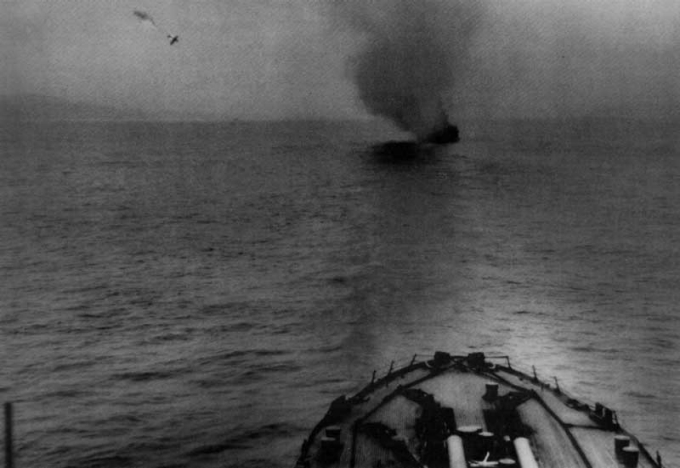
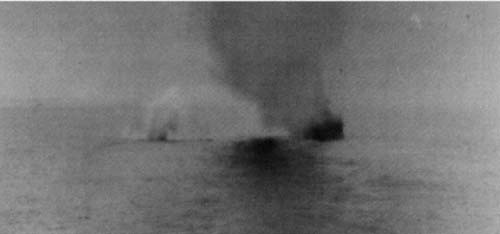
crippled by two previous planes." After Newcomb was hit by another plane, she lay dead in the water as Leutze gallantly pulled alongside to render assistance. In what seemed like no time at all, still another plane appeared out of nowhere and headed for the two destroyers. We stood powerless to intervene, our hearts in our mouths, as we watched it crash into its two motionless targets. We could not fire without hitting the ships. As we moved ahead with the ships of our formation, the two destroyers fell behind and out of sight.
--29--
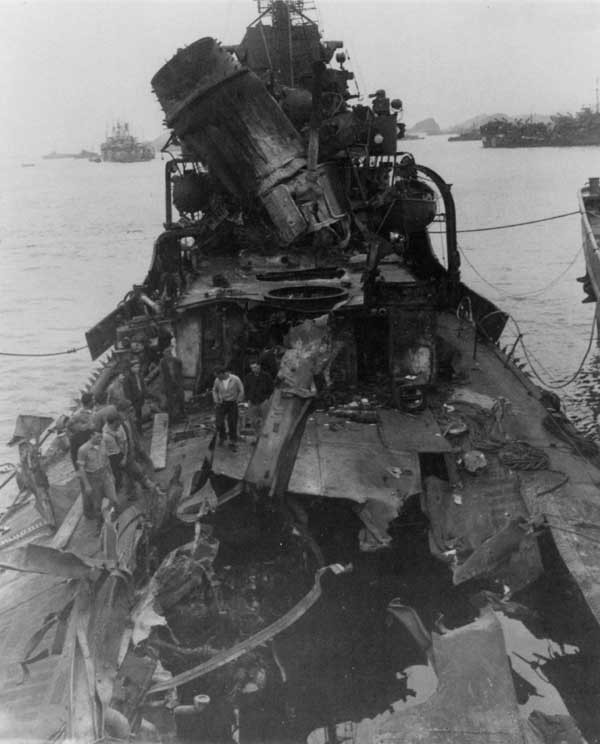
--30--
It was gratifying to learn later that both made it to Kerama Retto. Years later, while on a quail hunting trip in Florida, I got acquainted with Jim Walter, a businessman there who had left the Newcomb's crew just before Okinawa. Jim was due for a transfer and Commander Macmillian, Newcomb's skipper, had urged him to stay on for one more operation. But Jim apparently was ready for quieter waters after places like Surigao Strait. He probably made the right decision, since many of his fellow 40mm people were among Newcomb's 40 killed or missing men.
Our action was not quite over for the day. A twin-engine "Frances" was now seen to be circling the formation at perhaps 10 miles. As the plane turned in to attack, the 5-inch battery expended 89 rounds (including 58 VT shells), before the plane "crashed in [the] water near USS COLORADO." We claimed only an "assist," however.
Shortly before daylight on 7 April, the 5-inch guns, again in radar control, fired at another distant plane. Then things remained quiet until nearly 0930, when a lone "Val" made a determined suicide attempt on Idaho's port beam. The alarm was sounded for general quarters, but the plane was shot down before personnel could man their general quarters stations. Only three 5-inch mounts got into the action, instead of the usual five. The automatic weapons were considered to have gotten the plane and observers generally agreed that Duly had done the principal execution with his 40mm-quad. Duly later remembered:
On a lighter vein, I ... was off watch and taking a shower, all soaped up, when general quarters sounded and the 5-inch opened up. My stateroom was very close to the shower and I ran to the room, grabbed an alpaca lined hood and started barefoot for the gun director. I did open fire on the plane that was shot down and I had suds coming out of the alpaca hood in all directions. I looked over at the other Marine quad and a 20mm caught my eye. It was manned by a Marine corporal who worked in the bakeshop and had run to his 20mm battle station dressed in shoes, an apron opened in the back and a white baker's hat. I remember thinking what a picture the bare-ass gunner would have made for the cover of Life Magazine.
This action was especially notable in that a photographer in Texas (BB 35), behind us in column, was able to capture the progress of the entire attack. To a person experienced in antiaircraft gunnery, perhaps the most significant feature of these pictures is the smoke that seems to envelop the ship. People who see the pictures invariably say, "The ship has been hit!" The person who wrote the official Navy captions had evidently heard this often enough that he thought it necessary to comment:
"Smoke is entirely from antiaircraft batteries." Duly has since explained that the unusual volume of smoke was largely due to the flashless 5-inch ammunition, which produced little flash but much smoke. The ammunition produced considerably more smoke than usual, even with only three guns firing.
This activity caused great excitement, but more was yet to come before the day was over. Six battleships, with accompanying cruisers and destroyers, were to be sent out to intercept the ultimate kamikaze, the Japanese super battleship Yamato, as she headed for Okinawa, supposedly with just enough fuel for a one-way trip. Captain Grassie spoke to the ship's company on the speaker system to explain our strategy. Our battleships planned to intercept Yamato well before daylight to take advantage of our superior radar. It was hoped that we could do enough damage, particularly to her fire control installations, so that we could then close in to finish her off in daylight, thus minimizing the advantage of her massive 18.1-inch guns with their 3,200-pound projectiles. At 1848, in rather poor light, all ships fired their 5-inch guns at a "Kate" or "Val" moving parallel down the line of battleships. This plane passed down the battleship line and crash dived into Maryland (BB 46).
The rest of the day proved to be anticlimactic. When I was next alerted for dawn general quarters on 8 April, I learned that the aircraft from the fast carriers had sunk Yamato the previous afternoon.
--31--
Pondering the Kamikaze Hit on Maryland
The Maryland episode raises the fundamental question of fire discipline, which I believe can be defined as firing for maximum effect—usually a matter of range. Military history records many examples of fire discipline, especially in the celebrated victories of the outnumbered armies of great conquerors. Though the strategy of conquest was offensive, of course, the basic tactic was usually, of necessity, defensive. The spears of the Macedonian phalanx—the heart of Alexander's power—and the short swords of Caesar's legions relied on the fire discipline of the troops wielding them for their devastating effectiveness. Both forces were trained to thrust, which meant waiting until the opponent was so close you couldn't miss him. The Persian hordes of Darius and the howling Germani giants of Ariovistus never had a chance. They didn't understand fire discipline. In the age of gunpowder, every American boy has thrilled at Colonel Prescott's reputed admonition on Bunker Hill: "Don't fire until you see the whites of their eyes." And so it was at Okinawa. The U.S. Navy's mission was wholly offensive, but against Japan's ultimate weapon— the kamikaze pilot—the individual ship's tactical response was wholly defensive: When to give him the shaft? When to thrust? What about the whites of his eyes?
The range at which automatic weapons should engage enemy aircraft was a highly important question on which I found no general agreement. In Idaho, the antiaircraft officers never discussed this question, as we should have done. Nonetheless, I worked on the problem with the gun crews of my sector. Since the 20mm gunners and the 40mm director operators did not normally wear headphones, we contacted them through men wearing phones, standing beside them. On one occasion, when they commenced firing without orders at a very distant plane, I asked how far away they thought it was. They generally estimated about 2,000 yards. I then repeated the question to the operator of the Sky One 5-inch director just above us, which had radar. He said, "6,300 yards." When I reported this estimate to the gun crews, one of the men said, "The talker said he thought you had given 'commence firing.'" But this was still a controversial question.
Freddie Corales and many other officers felt that if the guns fired at a plane, no matter how far away, it might be discouraged from attacking your own ship and might choose another target. I felt that out-of-range firing at an approaching kamikaze was not only futile but counterproductive in several ways. It used up ready ammunition at the guns, obscured vision with smoke, and, probably in many cases, led to sloppy performance as a result of shooting before the reticles had settled down in smooth tracking. Perhaps worst of all, it had to have a devastating effect on morale when a kamikaze, who would surely kill you if he got in, kept right on coming in spite of your shooting. My view was that if we had waited for the plane to reach our effective range, and began firing only when all guns were tracking smoothly, then the enemy would be destroyed almost immediately by the enormous volume of projectiles converging on his nose. This is pretty much the way it turned out when our sector had its big test later on 12 April.
But after 50 years, the Maryland experience is still a great puzzle to me. There was no surprise, and the plane did not come in on a steep dive—the two usual causes of unsuccessful defense. As the plane flew parallel down the line of four battleships, all fired at it for long minutes at a moderate range of 6,000 yards. It is also a puzzle why those highly experienced 5-inch batteries did not get it. When the aircraft turned to attack, it went to the last ship of the line, probably to avoid or minimize crossfire from the other ships. Maryland's action report states, "Fire Discipline was satisfactory at all times, both during the bombardment and during antiaircraft action." If this is so, then what went wrong?
Much of the action report is devoted to deploring the obvious inadequacy of the obsolete 5-inch 25-caliber guns and to explaining that the radar and the 5-inch director had been unable to get on the plane until it was too close for the 5-inch fuses to arm. It notes, "Therefore, only direct hits were possible from the 5-in/25 battery,"
--32--
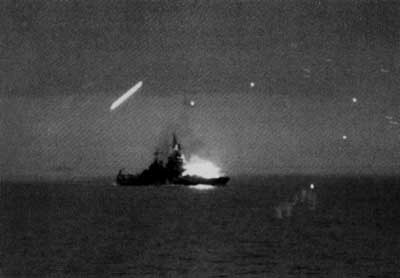
and added, "There was insufficient time to put on a set up that would obtain direct hits after the plane straightened out." What is this report saying? It is telling us that the shells could not explode, and that a direct hit was not possible. In other words, the situation of the ship's 5-inch 25-caliber guns was completely hopeless! I would argue that in these circumstances the automatic weapons, alone, should have been allowed to handle the attack without the distraction of the nasty concussion of the short-barreled 5-inch/25s and the addition of their smoke to a visual situation that was already marginal. The report seems almost to dismiss automatic weapons, stating, "This ship has seen nothing to cause it to reverse its former opinion that nothing short of 5-inch fire will stop such an attack."
But the admiral would not let that one go by. Only nine hours before the crash on Maryland, Rear Admiral Peter K. Fischler, Commander Battleship Division 5, had almost certainly stood at general quarters on the flag bridge of Texas and observed the convincing destruction of a diving "Val" by Idaho's automatic weapons, a performance that his flagship had photographed in its entirety. In his endorsement to the Maryland report he firmly demurred in the following paragraph:
4. Attention is invited to the fact that in contradiction to statements made in paragraph IV-A-I-(c) of this report, there are many known cases in which suicide planes have definitely been destroyed by guns of smaller caliber than 5". In view of the comments made by the MARYLAND in the subject paragraph, the question arises, "Is there an implied lack of confidence in the automatic weapons battery, that is, 20mm and 40mm installations?" Inasmuch as the attack described had all the elements of surprise in that it was not picked up by SK radar, and the plane first appeared through low-hanging overcast, it seems that this was definitely an automatic weapons' target, the value of these guns being their ability to deliver a high volume of fire at short range and their ability also to elevate and train quickly. It is not the intent herein to state or even imply that the 5" battery should not have been used, as this command is a firm believer in the basic policy of using all means to break up these attacks and destroy the planes, but it is also a firm believer in giving the 40mm battery its justly deserved credits because it has done well within its range limitations.
Aside from the obvious downgrading of the automatic weapons, perhaps the most telling statement in the entire action report is the following: "Even though two of the three 40mm director operators stated that they did not lose the plane at any time, it is felt that they lost their tracers before they reached the target because of the large number of tracers merging together and forming one bright flare."
--33--
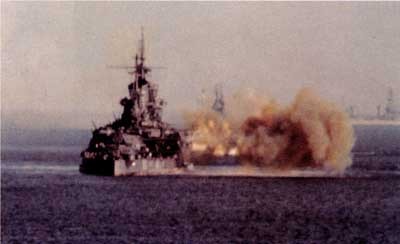
I am reminded of a remark made by John Maynard Keynes in a different context more than 70 years ago: "Is it more appropriate to smile or rage at such artless sentiments?" The writer in the Maryland report probably shared one characteristic with thousands of other officers in the U.S. Navy who were responsible for automatic weapons: he had never fired the guns himself. As I have already indicated, Duly, Bill Greenip, and I were aberrations in this respect. If such a presumably well-trained and experienced officer believed that a Mark 51 director operator should be following his tracers, he could hardly have been much help to the operator for whose training he was responsible. Fortunately, the enlisted men were intelligent and resourceful. Given half a chance to understand the equipment they were assigned to handle, they learned to use it effectively.
A plausible explanation for the impotence of Maryland's 40mm battery in this action appears in a single sentence in the report: "Observers in the foretop [probably our Sky Control] said that all 40mm tracers were going high although many of the 20mm were seen to hit." The range handle of the Mark 14 sight had three settings, starting at a maximum of 1,600 yards and clicking down to 800 and 400 yards. A sight held at a maximum setting of 1,600 yards would be expected to shoot higher and higher above an approaching target once it got inside the 1,600-yard range. Thus, if the range handle was not adjusted downward, once under the 40mm fire an approaching plane would become increasingly clear of the projectiles for some distance. I have referred to this as a theoretical explanation. It is true that this is the principle involved. But, in fact, the trajectory of the 40mm Bofors was so flat out to 1,600 yards that the super-elevation at that range would afford scant comfort to a plane seeking to get underneath its fire. Moreover, with the enormous volume of fire from three or four quads, together with the normal dispersion of the projectiles, the failure to get hits is simply beyond comprehension. I think my conclusion must be that the Maryland case remains a puzzle. But my basic recommendation remains in force: "Dry-track. Dry-track. Dry-track." Everybody would have been surprised at how much could have been accomplished by that simple practice.
It is perhaps not surprising that our opponents also had trouble with fire discipline. Both the "death-bed testimony" of Rear Admiral Inoguchi, skipper of the giant battleship Musashi (sister ship of Yamato) and the celebrated diary of Admiral Ugaki, "an expert on gunnery and also the gunfire supervisor of the fleet," brought out the Japanese problems with antiaircraft fire. On 24 October 1944, during the Battle of Leyte Gulf, as Musashi's flooding became uncontrollable after receiving 19 torpedo and 17 bomb hits, Inoguchi wrote a final statement at the request of Captain Kato, the ship's executive officer. In the tradition of sea captains everywhere, he took the blame for everything that went wrong:
Another thing for which I could not be excused in this battle was that the power of antiaircraft firing was not fully displayed. Every ship seemed to be poor, for which I felt myself quite responsible. It seemed that they fired excessively, thus inviting a disadvantage of losing targets. Also, cases of firing at long range and firing at running away targets were many.
He also commented, "I think machine guns must be more pow-
--34--
erful. In spite of machine gun hits, enemy planes did not fall easily." The TBF was indeed a tough airplane, and Inoguchi's largest automatic weapons were only 25mm machine guns. If he had had anything to compare with our 40mm-quads, with their Mark 51 directors and Mark 14 sights, it might have been a much different story.
I have quoted only a small part of what was a moving and poignant message. Thirty-two minutes after Admiral Inoguchi finished his letter, Musashi suddenly capsized and sank. Across the long intervening years, we can feel a strong empathy with this fine officer and realize that he was a kindred spirit.
By listening to the Inter-Fighter Director (IFD) radio network, those of us in Sky Control were always able to follow the progress of air raids. The IFD net, which was turned on at all times, gave us complete information on the progress of attacks. It is impossible to comprehend the full historical significance of the Okinawa operation with its more than 1,500 suicide aircraft, or indeed of warfare against Japan, without understanding the defensive arrangements, of which the IFD net was the coordinating and connecting structure.
When air attack became the principal naval threat in the Pacific War, a centralized defense became the first requirement for survival. Fighter planes, directed to incoming targets by a fighter director and his crew, were the first line of defense against the threat of multiple raids. The fighter director, in radio contact with the combat air patrol, directed the planes to intercept the enemy targets, known as "bogeys." This general air defense organization worked whether defending a fleet at sea or islands like Iwo Jima and Okinawa. When the fighter director sent his CAP to intercept an enemy raid, he first had to know its location relative to a fixed point. Every island invasion plan designated a specific point for this purpose. At Iwo Jima it was the volcanic peak of Mount Suribachi, not surprisingly called "Hot Rocks." At Okinawa it was Cape Zampa Misaki, on the island's west coast, designated "Point Bolo."
By this time in the war, to afford the longest possible warning, destroyers were sent ahead of the fleet or were stationed beyond the island targets, always placing themselves between the defending fleet or base and the expected direction of the attackers. These ships were known as radar pickets—performing the picket's traditional military function of guarding against surprise. At Okinawa the Navy had 16 different radar picket stations, though not all of them were occupied at all times. This duty was extremely hazardous because the Japanese tended to concentrate their attacks against the pickets. To afford extra protection, radar picket destroyers were stationed in pairs as often as possible, and at various times two to four LCI(G) gunboats with their strong antiaircraft batteries were sent along for support. Most importantly, the pickets were supposed to have their own CAP overhead, operating under their own fighter director. But CAP defense was often uncertain, as planes were limited by weather conditions and also had to leave the picket area as darkness fell. Morison points out, "Twilight was the kamikazes' favorite hour." Unlike the U.S. Navy's combat air patrol fighters, the Japanese "pilots of the purple twilight" didn't have the problem of finding their way home in the dark.
In spite of all the Navy's precautions, the experiences of the picket destroyers were terrifying beyond description, with many ships sunk and many more severely damaged, with great loss of life. Destroyer Laffey (DD 724), despite having a CAP overhead, was the object of 22 separate attacks and was hit by six kamikazes and four bombs, losing 31 killed and 72 wounded— nearly a third of her crew. Yet the ship survived the onslaught and was repaired.
On the day that Laffey suffered this disastrous attack, Admiral Turner, who had planned the amphibious aspects of the Okinawa operation and was directing it from his flagship Eldorado (AGC 11), sent Admiral Chester W. Nimitz, Commander in Chief, Pacific Fleet, 28 photographs of ships—mainly destroyers—that had been damaged by suicide planes. Anyone looking at these terrible pictures would wonder how anyone at all managed to live through so much devastation. In his covering letter Admiral Turner said:
These will give you an idea of what our boys are going through. How they ever get their ships back is a mystery; but they are cheerful and do
--35--
everything they can to keep their ships up here instead of being sent to the rear areas. Morale seems very high, even among our radar picket vessels who well realize what they are up against as do all of us, and they are willing to fight it out on this line.
This then was the structure of the Inter-Fighter Director net and its main players: the fighter director himself, the radar pickets, the combat air patrol, and their enemy targets. The IFD net was at once our salvation and our entertainment. It prepared us to defend ourselves by following the progress of approaching enemies and, of course, under the circumstances it was perfectly fascinating. There could be no small talk on the IFD. Its function was too critical for that. In the midst of a number of raids, even the most heartrending appeal for help received a curt dismissal. To understand an exchange coming in over the IFD net, it is necessary to know the lingo. After perhaps hours of complete silence, a typical opening exchange might go something like this: "Delegate Base [USS Eldorado], this is Helpmate [a radar picket destroyer]. We see bogey 325, 95, Angels 10, 15 to 20 A/C."
To this, the fighter director on Admiral Turner's flagship would respond immediately: "This is Delegate Base. Roger, Helpmate. We have your message."
He then would inform the eagerly listening world: "Exbrook [all ships present]. Exbrook. This is Delegate Base. We designate Helpmate's bogey, Raid One."
Helpmate's message translates like this: "We see a bogey bearing 325 degrees from Point Bolo, 95 miles from Point Bolo, at 10,000 feet elevation, and comprising an estimated 15 to 20 aircraft." In reporting distance or bearing, if there was no hurry, the picket destroyer sometimes said, "90 miles [or the bearing] from Point Bolo," but usually Point Bolo was simply understood. Radar picket destroyers had meaningless call names like "Helpmate," "Horseface," or "Errol Flynn," to mention a few. On busy occasions, 6—7 April and 12—13 April, for example, the raids came thick and fast. The fighter director spoke rapidly but never excitedly and kept assigning numbers to the raids as the pickets reported them. The numbers sometimes got up into the 20s, though keeping the raids separate could not have been easy. But the numbering was important in order to give the various CAP groups the correct vector, or line, for intercepting each raid. The combat air patrol units, usually consisting of four planes, had imaginative call names like "Ruby 2" or "Sharpshooter 3" and were sometimes brought in on the IFD net to try to coach them onto a bogey that was proving difficult to find. This color livened up the show, to the great delight of all of us who were listening. We might hear the fighter director saying something like this to a CAP unit: "We see merged plot [bogey and CAP are so close together they show up as one blip on the radar]. You should be getting a Talleyho [enemy in sight] soon."
The young pilots on combat air patrol were always eager and enthusiastic, often seeking to report their successes or "splashes." The fighter director was never rude or abrupt with them, for they were key people in the game. He would just say, "I will take your splash reports later." Once, when a ship broke into the IFD net saying, "We are in a sinking condition," the response was, "Stay off this circuit. We are handling a big raid"—which the unfortunate reporting ship knew all too well. After all, it was not a radio net that was able to send out any help, while, on the other hand, the CAP fighters were players in the game.
Sometimes circuits were left open, and I remember once hearing a pilot exclaim in obvious surprise, "That bogey shot at me!" That the pilot considered the shooting unusual was an indication of just how ill-prepared most of these young Japanese pilots were for anything other than suicide crashing. Even then they often missed the target ship and crashed into the sea. Kamikazes did not usually come out in numbers at night, although a few ships were hit in moonlight. Snoopers, however, did come around at times, and night fighters attempted to destroy them. One night when the fighter director had the night fighter on the circuit with him, he made a determined effort to get a snooper who obviously knew enough English to eavesdrop on that circuit. Apparently the fighter had been near the snooper more than once but could not locate him. The fighter director said, "We have merged plot again. Now see if
--36--
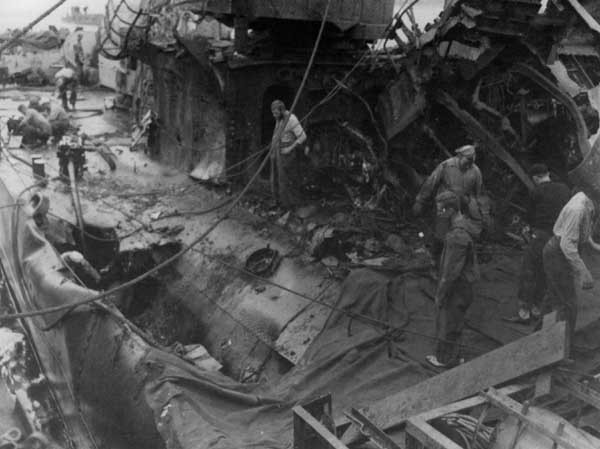
you can get him this time." The Japanese pilot had managed to tune in on the circuit and interrupted with a raucous and derisive "haw, haw, haw, haw."
Although we were never attacked at night, we were always uneasy when it was dark and we could not readily defend ourselves. Later on, though, smoke provided a satisfactory solution to our nighttime nakedness. Instead of going out to sea in a night retirement, the bombardment ships began anchoring along with the numerous auxiliaries. It was on one such evening, during a general alarm, that the transports somehow got started firing—mainly the "friend-deadly" 20mms. We all cowered down, looking at each other in consternation until the shooting finally ended. I remember that Bish later remarked jokingly, "That was one time Sky Control retreated." But usually when we were at anchor and a bogey was reported at some distance, we would hear over a loud speaker, "Conductor [Admiral Turner] says, 'Make smoke. Make smoke.'" Smoke generators would soon have us all buried in a heavy bluish haze. I wondered what would happen if a bunch of kamikazes came around and saw a lot of masts sticking up out of the smoke. I guess it never happened, because, as far as I know, there were no attacks in the smoke. It turned out to be a pretty secure feeling.
--37--
The crucial historical significance of the whole radar-warning and interception system now becomes clear. It saved the entire Okinawa operation. As Dr. Vannevar Bush, director of the National Defense Research Council, said after the war, "At Okinawa without radar the Japanese might have been able to say, 'The bigger they come, the harder they fall!'" But it also had crucial significance for the modern debate concerning the casualties that might have been incurred if we had invaded Japan instead of dropping the atomic bomb. The great majority of pilots who flew from Japan intent upon making a suicide crash never saw an American ship. They were detected by radar and shot down far short of their intended targets by the CAP fighters. Suicide planes had to travel over a several hundred-mile stretch of largely empty ocean before reaching their intended victims off Okinawa. It was this distance that made it possible for our radar to detect and intercept the planes so effectively. We knew the odds facing the forces who would be invading the Japanese Home Islands. There would be no ocean between the ships and their attackers, and little opportunity for radar warning. Considering the destruction caused by the relatively few kamikazes that got past our combat air patrols at Okinawa, it is chilling to contemplate the situation had we invaded Kyushu, where our CAPs would have had to operate without advanced warning of incoming planes.
"Floating Chrysanthemums"
There were no more big attacks in our area until 12 April, when we were told to expect heavy air attacks. Years later Admiral Morison, who was present at the time, wrote, "April 12 proved to be one of the most trying days for the Navy in this campaign." We always received warnings of impending big raids. These alerts came from the breaking of JN-25, the Japanese Navy's general purpose code. Our people were so expert at decryption by this time that the Japanese practice of changing the code's protective encipherment each month made little difference. For example, the change introduced on 1 April was broken the next day. Whenever the word came over the IFD net, "Exbrook. Exbrook. Conductor says, 'Flash Red [enemy planes approaching], Control Yellow [warning alert— nothing is near enough yet to shoot],'" we would go to general quarters. General quarters was a startling and arresting break in a ship's routine. And after a while at Okinawa it could be scary. We had witnessed a lot of bloodshed in those first weeks. In the officers' wardroom I have seen glasses overturned at the table when people jumped up at the sound of the gong. Our alarm signal was not a semi-buzzer type found on later ships. It was a true, clear bell with a rapid, ominous ring that would wake the dead. Then, almost instantly from our superb bugler would come the staccato notes of general quarters: "Ta dadada. Ta dadada. Ta dadada. Ta dada. Ta dadada. Ta dadada. Ta dadada. Ta dada." And over the loudspeaker (and I do mean loud) would come: "General Quarters. All hands, man your battle stations." Then, allowing time for everyone to get in place (if you ran fast enough), the speaker would proclaim, "Now set Condition Zebra. Set Condition Zebra." This meant close all watertight doors, referring to most of the ship's hatches. This accomplished, the ship was now "buttoned up." However, on this day we had all gone to general quarters long before any raid reached our vicinity. We knew they were coming, and all of the bombardment ships were gathered together for mutual support. At one point, I counted 11 battleships and 10 cruisers in a great circle, reminding me of circling the wagons in the old Westerns. Outside and beyond these heavy ships was a thin pro-
--38--
tective screen of 12 destroyers. Admiral Morison reported this day from his position in Tennessee, only 2,000-3,000 yards from us, and though all remained quiet until 1326, we kept to our battle stations and our ships kept their defensive cruising disposition. As on board Tennessee, we in Idaho had sandwiches at our battle stations. The automatic weapons crews had stacked extra ready ammunition around their guns, and the air was electric.
Then at 1326 over the IFD net came the word, "Exbrook. Exbrook. Conductor says, 'Flash Red, Control Green [shoot on sight].'" Now the IFD net crackled steadily with reports of raids and directions to the combat air patrol units. As was usually the case, most of the aerial interceptions were successful, but, as often happened, a few were not. One raid kept eluding the CAP and kept on coming. Finally, when they were perhaps only 20 or 30 miles away, I told the telephone talkers to get the gun pointers on the phone. I said to them, "This raid is getting through, and it looks as if we are going to have to shoot. If you guys don't think you can hear the talkers, put the phones on your own heads." (This was the last thing that either they or I wanted, of course.) Then over the phone we all heard, "Mr. Wallace, this is Earl. We won't shoot until you give the order." I knew then that everything was going to be all right and that everybody was going to be confident and calm. Earl, on a 40mm director, was my senior fire controlman and was as solid as a rock. At just about this moment, two great flamers appeared, falling so slowly, it seemed, toward the water. To Admiral Morison they seemed like meteors, an apt description, since they appeared very bright in the clear sky. In his description of the event, though, he does not mention the white parachute I saw descending slowly from the sky to the sea. But then, we were a bit nearer than Tennessee was to the scene.
We could clearly
see his tracers, in a full
deflection shot,
seeming to curve
into the cockpit.
Almost immediately the screen opened fire, and we could see the attacking planes skimming low over the glassy sea. It could not have been a prettier show for our sector. The first one was a glider that came directly into the sector where I knew that all of our reticles were tracking smoothly and patiently. In my supreme confidence I waited perhaps too long for the nerves of most of those assembled, but I knew my guns and I knew my guys. Bish slapped me on the shoulder saying, "Shoot. Shoot." At 1448.10 I held my speaker button down and said, "All guns commence firing." As he was now in range of both the ship's 20s and the quad-40s, a neat and symmetrical triangle of tracers came to a point on his nose. With the convergence of so much destructive power, he was in the water within seconds. The action report records that after 25 seconds of firing (at 1448.35) the antiaircraft battery checked fire.
After a 40-second break, at 1449.15 the port side, including our forward sector, destroyed another plane in a 30-second flurry of firing that ended at 1449.45. Like the first one, this kamikaze was smothered by automatic weapons fire and did not even get near the ship. Then came a stellar performance by one of my teenagers standing in a 20mm gun tub right next to us in Sky Control. He was a nice, quiet kid from somewhere in the South. One of the Japanese pilots, possibly noticing that his compatriots were not having much luck with Idaho, or perhaps by a prearranged plan, swerved to go past, possibly to go around and attack the ship from a different angle. (This also happened to Tennessee.) He could not have been much more than one or two football fields away as he tried to pass ahead on our side. The kid had been one of my most conscientious charges in working hard to master the Mark 14 reticle, and he didn't miss a beat in quickly getting a smooth track. He held his firing lever back for just 15 seconds, but that was enough. We could clearly see his tracers, in a full 90-degree deflection shot, seeming to curve into the cockpit. A ball of fire, the plane crashed harmlessly into the China Sea. Bish looked at me gleefully and
--39--
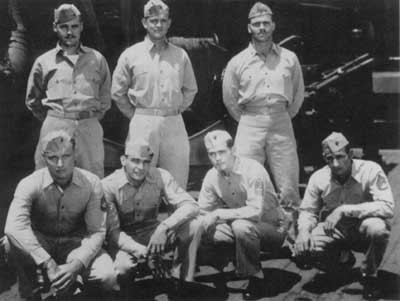
pointed to our 20mm gunner. It was clearly a one-man feat, done at his own initiative and without orders from anyone.
Located up high at Sky Control level, our young gunner probably had a better view of the whole picture than others located farther down and somewhat immersed in gun smoke. No doubt also most people had their attention fixed on the serious trouble now approaching so far back on the port quarter that only their guns could bear, and as it turned out not all of those. Two "Kates," working as a team, approached, with one a few seconds ahead and slightly to the side of the other. The 20mm guns in the Marines' sector were firing steadily, but now came the great spectacle of our afternoon. One of our 5-inch guns made one of those rare direct hits that simply obliterates any single-engine plane, especially one carrying a bomb that becomes part of the explosion. The impression is always astonishing, because a rapidly moving aircraft seems to stop instantly, like the film stopping in the middle of an old Keystone Kop comedy. In the daytime when this occurs there is nothing to see but a heavy, motionless column of black smoke. In the night sky, the plane again stops suddenly, but out of the orange fireball one can see a shower of red sparks. I have always thought these were parts of the steel engine disintegrated by the double explosion. But now we were subjected to a desperate sequel to this lucky hit on the lead plane. That plane exploded close aboard the port quarter. Both planes were taking 20mm hits when the nearer one blew up.
If we felt any elation at this sudden turn of events, it soon turned to dismay as the sagacious surviving pilot swung quickly in behind the sheltering pall of his companion's destruction. He was hidden and our Marines could no longer shoot at him. But the alert Marine loaders apparently took these brief seconds to put fresh drums on their 20mm Oerlikons. When he emerged from the smoke, determinedly bearing down on the ship and seeking to strafe with his machine gun, he began absorbing heavy fire from the Marines' 20mms. As the kamikaze approached the ship, I had the
--40--
impression of a man with great sores breaking out all over his face. He did not stop, but his plane could not take so much fire. As he began to fall he headed directly for a young Marine who, like our 20mm gunner in Sky Control, was a real pro. He stood there in his tub and fired down the throat of his attacker until the very moment of impact. As I saw the plane seeming to plow into the ship, I bent over to avoid the blast and shock.
A bomb exploding so close to you does not make a booming sound, as heard in the movies. It makes a crackling sound, like lightning. Even in our high-up position in the forward part of the ship, we were literally showered with debris. A piece of engine block landed in Sky One, the 5-inch director above us, and I picked up from our deck an aluminum rivet with a copper wire attached.
The official reports gave different estimates of the plane's distance from the ship when it exploded, ranging from 25 feet to 50 yards. Obviously, the man who wrote the 50-yard estimate was not a witness. I watched the plane to the moment of impact, and I would estimate it was more like 15 or 20 feet away, at most. A more distant explosion was not likely to do all the damage that this one caused. Eight blisters were flooded on Idaho’s port side, and the ship suffered extensive damage from flying shrapnel and the shock of the explosion. Personnel suffered a number of minor shrapnel wounds, but amazingly only two of these were serious enough to require a short stay in sickbay. Both men were retained on board. The Marine who continued to fire up to the moment of impact was only slightly shaken up, I would guess because the bomb exploded so near that he was protected by the armored side of the great ship on which he was standing. An interesting footnote to this event was that several name plates of various kinds were found among the
A bomb exploding
so close to you
does not make a
booming sound, as
heard in the
movies. It makes a
crackling sound,
like lightning.
debris. I saw a small ballbearing race around which were the letters: "NORMA NAM MADE IN USA."
In the ship's action report this extended kamikaze attack was summarized succinctly:
1452 Antiaircraft Battery checked fire. Two VALS and three KATES shot down and assisted in shooting down one KATE. One plane exploded close aboard Port quarter. A second plane was splashed close aboard Port quarter and exploded, flooding eight blisters on the Port side, spraying the ship with shrapnel, and damaging other installations aboard the ship. Ammunition expended: 52 MC and 75 VT Projectiles with charges, 1273 40mm and 3468 20mm cartridges.
In describing this attack from memory as well as on the basis of Idaho's action report, an important unexplained question came up: Why were the 40mm-quads, which would have disposed of this last plane long before it reached the ship, not firing at all? Bob Daley was easy to locate through the St. Olaf Alumni Office. I talked with him at his ranch near Rifle, Colorado, but Bob could not remember. Dulaney, who pointed a quad, would surely have the answer, but I had to find him. With the help of the National Personnel Records Center in St. Louis and my daughter in the Pentagon, I soon located Duly. In the course of an enjoyable telephone visit with him, I got the answer to the mystery of the 40mm-quads. The plane was too low for the quads to be depressed that far. All automatic weapons had positive-limit stops to prevent them from firing into their own ship. To me, perhaps the strangest riddle of all is why it took 50 years for somebody to raise the question. And perhaps more importantly, why, after such a horrendous experience, was the difficulty not relieved the very next day. All that was necessary to correct the problem was to cut the splinter shield a bit lower in front and then lower the limit stops accordingly
--41--
Attacks on Idaho and Tennessee
I sent Duly an early draft of this manuscript, and he promptly sent me a long letter recalling these actions. His memory proved to be excellent and, like my own, largely in accord with the ship's war diary and action reports. His recollection of 12 April is about the same as mine in the broad picture, with only the difference one might expect from his perspective in another part of the ship. I was high forward in Sky Control, while he was well aft, nearer to deck level in his upper quad. His fascinating account follows:
My recollections are more anecdotal than factual, with much less certainty as to dates despite the fact that my long memory I find is, generally speaking, better than my short memory.
First of all, on the attacks on April 6 and April 12, I remember one of the officers on board stating that a class had graduated from "Kamikaze High School" in Japan and that the planes were all headed south! On the April 12 attack on the port quarter of the Idaho, I have a very clear recollection that there were three Japanese planes flying very low and in line. As they came through the screen between the destroyers, a lone 20mm on the bow of a destroyer, or possibly a destroyer escort, shot down the rear or third "Jap" plane. [This was probably the work of another hotshot like my teenager.] The five-inch from the Idaho blasted the lead plane and the remaining plane continued to bore in, barely above the water. I really don't think the 20mm bothered the last "Jap" plane all that much and the two port quarter quad forties could not depress enough to fire until the "Jap" pilot tried to gain altitude to hit the superstructure of the ship. The two rear quad forties opened up fully loaded and at point blank range having been tracking the plane for at least 100 yards. The plane did a wing over and went into the water very close to the lower Marine quad (Bill Greenip, a Marine second lieutenant, had the director) and blew a hole in the blister and put about 50 gallons of water in the lower gun mount. My upper quad got some water and I remember running my hand over my helmet and licking it to be sure it wasn't gasoline as I had a very positive fear of burns.
I later learned that the Marine sergeant in charge of Bill Greenip's quad had stood by the loaders with a 40mm round in his hand and threatened to clobber any loader who even looked up at the oncoming plane. I didn't realize it until I ran across some photos that the Marine enlisted men received 24 Letters of Commendation and 12 Bronze Stars for the April 6 and 12 actions.
The close aboard explosion of the kamikaze bomb cut-up the signal halyards which came down all around my director and entangled it. I took a knife and cut-away the halyards and as I did so I saw Lieutenant Hubert Woods (my roommate "Woody") jumping up and down on the wing of the bridge and shaking his fist at me. Replacing signal halyards was a particularly difficult, dangerous and time-consuming job. I also recall that the small canvas flag, flown on the Idaho, was cut down by shrapnel and in a few minutes a huge flag was raised in its place to the cheers of the top-side gun crews. The large flag had to be replaced almost immediately because it interfered with the after director, and it was replaced with a smaller canvas flag.
I would have left the story of the 12 April attack at this point had I not met Jim Rodgers of Miromar, Florida. Jim was a 19-year-old Marine 20mm gunner on Tennessee. During the 50th anniversary visit by the American Battleship Association to Tokyo Bay on 2 September 1995, he and I discussed that attack at length. He told me that while the antiaircraft batteries on Tennessee were absorbed with five or six planes that came in more or less together, all on the port side, one plane alone (which Jim believed was by a prearranged plan) came in from dead ahead and crashed into the ship. This fact immediately suggested that the plane destroyed by my teenager was attempting to perform a similar end run using
--42--
the same plan. After all, they were part of the same raid, and they had surely been briefed together before taking off from Japan. But for our gallant young 20mm gunner, such a scheme could well have succeeded against Idaho.
This then accounts for about everything, except for our enemy parachutist. But he was not left to drown. As it turned out, we always seemed to treat the kamikazes better than they treated us. The best thing that could happen to a kamikaze pilot was for us to shoot him down. In fact, it was the only way he could possibly survive, and there are several examples of this happening. Admiral Mitscher with Task Force 58 reported picking up one on 6 April, when he bailed out after the CAP shot him down. The one I saw jump out of the burning plane on 12 April was delivered to us by the destroyer that had picked him up. Idaho had facilities for such detainees. We were the flagship of Rear Admiral Lynde D. McCormick, whose staff could question and process a captive. It turned out that the Japanese survivor was a better mathematician than any of our Marines who supervised him in the brig. They could not talk with him, but they did challenge him to exchange math problems. That proved to be a big mistake, at least for the Marines' self-esteem. He quickly demonstrated the math superiority that Japanese students today are said to possess over their American counterparts. His presence in the company of largely green young men was now explained. Instead of
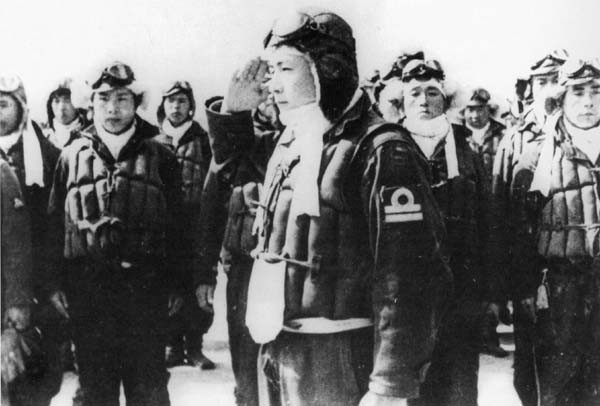
--43--
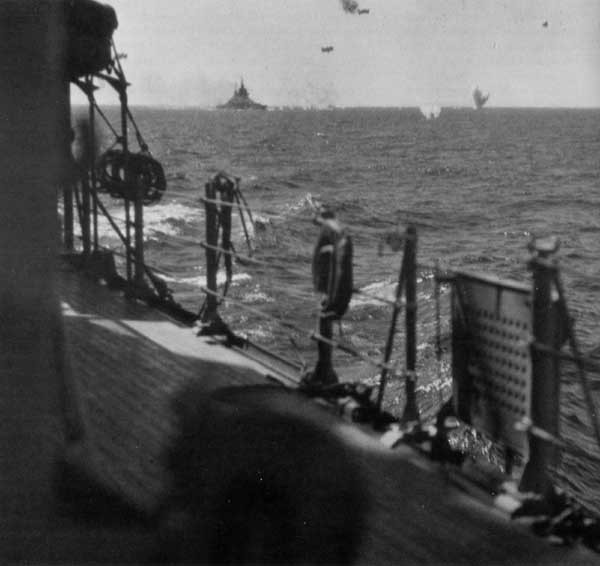
being a pilot, he was a navigator. Though most of the pilots he guided had very limited flying skills, they could remain in a body and follow a leader. There could have been 25 or 30 planes in that group of kamikazes, since Idaho, with six kills, was only one of several ships attacked at almost exactly the same time. Tennessee accounted for an equal number, and there were many other ships present whose experiences, like Idaho's, have never been generally known. Zellars (DD 777), in company with Tennessee, was hit by another plane while other kamikazes, like the one from which the navigator survived, fell to our combat air patrols. The ones we saw shot down by CAP
--44--
were flying at a fairly high altitude, suggesting that the relative immunity for most in this large raid was perhaps due to their approaching at sea level, thereby escaping the notice of our fighter planes high above.
The kamikaze pilot escape story to top all such rare tales, however, hit the American media only during our celebration of the 50th anniversary of the war's end. On 25 May 1945, 21-year-old Kaoru Hasegawa, armed with a 1,760-pound bomb, drew a bead on San Francisco (CA 38) in a suicide dive that took him over the highly experienced gunners of the destroyer Callaghan (DD 792), who promptly shot him down. In one of those rare cases when neither the plane's fuel nor its bomb exploded, he was only knocked unconscious. In the standard practice for friend or foe, Callaghan sent boats to pick up any survivors and brought him back aboard. When he regained consciousness, he was appalled to find that he was not dead. In fact, when he was transferred to our sister ship, New Mexico (BB 40), which also had facilities for processing prisoners, he tried to commit suicide. But he survived to go to a prisoner-of-war camp in Hawaii. Now president of a paper manufacturing company in Osaka, he spent a year researching records to find survivors of Callaghan. On 29 July 1995, he got together with 100 survivors of that gallant ship. After leading an absolutely charmed life in the Okinawa operation, shooting down 12 kamikazes, including Kaoru Hasegawa, Callaghan was sunk in the moonlight by an ancient wood and fabric biplane whose flimsy construction would not detonate her VT fuses. She was the last ship to be sunk at Okinawa. Her deadly machine gunners could not fire in the night, leaving her totally dependent on her radar-controlled main battery. In addition to his reunion with the 100 men of Callaghan's crew, who made him an honorary member of their Survivors' Association, Mr. Hasegawa went to the Navy Memorial in Washington, where he laid a wreath and contributed $10,000 to the memorial fund in appreciation of Callaghan's crew.
Idaho's shooting that day was not quite completed. About an hour after sustaining the damage to her blisters, her 5-inch guns fired six VT and seven AAC rounds at a plane far off on the starboard bow, claiming an "assist" when it crashed at 10,000 yards.
The shooting on the 12th was over but not the excitement. Even though we secured from general quarters and commenced night retirement northward with the rest of Task Force 54, so much action made the crews nervous. We went to general quarters again when enemy aircraft were reported closing the formation, but soon secured when they merely orbited and did not come closer. They were just waiting for darkness. I had the evening watch, which
--45--
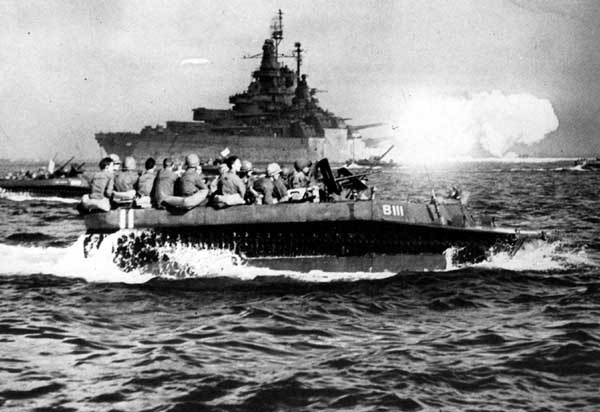
ended at 2000 when it was almost dark. I had been listening to these orbiting bogeys on the IFD for a long time, but now, 50 years later, I suspect that I did not realize what it meant. When my relief came to Sky Control just before 2000, I started down the ladders over several deck levels, heading below, when a man in one of the gun crews I passed said, "Mr. Wallace, you may as well go back. They are coming in and we are about to go to general quarters." Through their telephone talkers, these crews kept constant contact with the IFD net in Sky Control; it was, after all, their main business in life. Almost as he spoke, a bright flare lit up the sky. Admiral Morison wrote that they were the brightest anyone in Tennessee had ever seen. They were bright indeed. As the bugle sounded for general quarters, I counted them— 1, 2, 3—to a total of 16. It seemed bright as day on the ship, but you could not see out into the enveloping darkness. This made me think of a bullfrog sitting in a spotlight waiting for someone to stick a gig in his back. Rear Admiral Morton L. Deyo, Commander TF 54, ordered increased speed and a turning to try to dodge the torpedoes, which we knew were coming. In short order, both Idaho and Tennessee were heavily shaken by huge underwater explosions close aboard. For a moment I thought a torpedo had hit us. Our action report speculated that it was "probably [a] self destroying torpedo." But in the literature I have not seen any references to self-destroying Japanese torpedoes, except for Admiral Ugaki's suggestion of "too much sensitivity of the exploder" and a report of several cases of
--46--
"self-explosion" before reaching their targets. My own theory is that, like Commander P. D. Gallery's 1.1-inch shells that would explode in heavy rain, these torpedoes had sensitive detonators that were set off by the turbulence in the immediate wake of a large speeding ship. Our explosion was close enough to cause consternation among the crew, one of whom asked in obvious trepidation, "Mr. Wallace, what was that?"
Admiral Arleigh Burke had a similar scare at Cape St. George near Rabaul in November 1943. Through information derived from the Japanese naval messages decrypted by Navy code breakers, he ambushed and quickly destroyed two ships of a five-ship destroyer force engaged in a midnight Tokyo Express evacuation of key aviation personnel. While engaged in a long stern chase, during which he eventually destroyed a third ship, his sixth sense told him they would probably be sending some Long Lance torpedoes in his direction. Shortly after he had ordered a 45-degree turn to the right, the ships of his formation were badly shaken up by violent explosions in their wakes. Each ship thought the others had been hit, and Burke later said that he automatically looked towards his forecastle "to see if it was still there." Considering the violence of the explosion we experienced on a battleship, it is easy to imagine how severe it must have been on these far smaller vessels.
We were all much relieved by our escape from all of these dangers, which we now thoroughly understood. We had seen the devastation on board the nearby Tennessee, which had knocked down about as many planes as we had. We were just lucky that all of ours had come in low and could not crash aboard after being heavily hit, as had happened to Tennessee, and two weeks earlier to Nevada.
Time "Off the Line"
In the early hours of 13 April, we were all shocked to hear of the death of President Franklin D. Roosevelt. Many could not believe it at first, and I was one of them. He was a sort of patron saint to the U.S. Navy. In his pictures with Churchill and Stalin, we see him wearing his favorite outer garment, a Navy officer's cape. In conversation he was sometimes heard to refer to the Navy as "we" and the Army as "they." During his first administration, when the Navy could not get money for desperately needed ships, and the conservative Secretary of the Interior, Harold Ickes, would not approve funds from the Public Works Administration, the President stepped into the breach in his characteristic and decisive manner. By executive order, he transferred $238 million of public works money to the U.S. Navy for ship construction. Just how important this decision was for the Navy, for the nation, and for the war against Japan is dramatized by the record of just two of the ships built with that money. Yorktown (CV 5) and her sister Enterprise (CV 6) were built for just under (hold onto your hat) $30 million each! When we consider that during the Battle of Midway their planes, in a single day, destroyed four Japanese fleet carriers—two-thirds of Admiral Yamamoto's first-line carrier fleet—and brought about the turning point of the war less than six months after Pearl Harbor, we must conclude that this was probably the best ship investment in history. It is true that Sir Francis Drake's Golden Hind in 1580 paid off England's national debt in a single voyage. But that was only money. The great President had always stood by the Navy, and the Navy remembered. By order of Secretary of the Navy James V. Forrestal, memorial services were held on every ship and shore station on 15 April.
In spite of hull damage, which could only be repaired in dry dock,
--47--
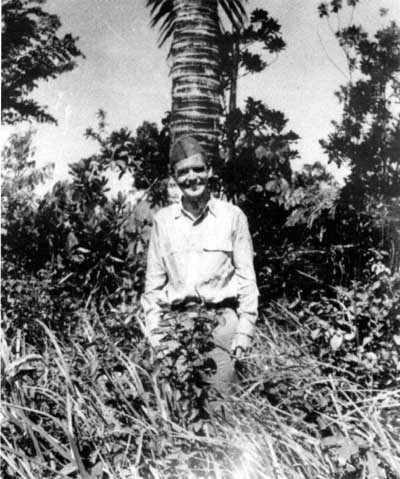
Idaho remained at Okinawa until April 20. We were needed. By this time General Ushijima's troops were reacting strongly, and much of this defensive effort was well within range of his great American amphibious nemesis—naval gunfire. There was no rest for Japan's "Soldiers of the Sun." Even darkness afforded no cover. Japanese diarists across the Pacific noted from time to time the particular misery of battleship punishment. We were relentless. The favorite Japanese tactic of attack under cover of darkness suffered serious handicap here. Ships kept up all-night illumination with 5-inch/38 star shells, which left no place for the Japanese troops to hide. This activity was interspersed with appropriately timed harassment fire, scattering shells over any area where enemy activity was seen or expected. When troops were seen or believed to be moving in an area, the harassing fire included airbursts just overhead. Foxholes afforded no shelter from these aerial assaults. Worse than this, on one night we even fired harassing air-bursts with our 14-inch/50 main battery when an attempted troop movement was observed or reported. The black airburst of a 14-inch shell is a most impressive thing to observe from a ship, but surely is more frightful to one on the receiving end.
To keep us on our toes, prowling kamikazes punctuated this activity with frequent air alarms. In addition to our normal dawn general quarters, on nine separate occasions during 13-17 April, we heard over the IFD from Admiral Turner on Eldorado: "Exbrook. Exbrook. This is Delegate Base. Conductor says, 'Flash Red, Control Green.'"
Although the third of the great TEN Go (or Kikusui) raids came on 15-16 April, so effective was the interception by CAP and the antiaircraft fire of ships between us and the Japanese bases that we saw little of the 165 "Floating Chrysanthemums" who sought our blood. The ships that paid for our immunity were principally the carrier Intrepid (CV 11) and the six radar picket destroyers that were heavily hit on 16 April, including Pringle (DD 477), which was sunk. This raid was on the same day that Laffey survived 22 separate attacks in some 80 minutes.
--48--
One plane did get close enough to Idaho on the 16th for our 5-inch/38 battery to destroy it, using only eight rounds of AA Common. It might seem that success so spoiled us that we were almost casual in our defensive efforts, not even employing VT ammunition in this case. But there was nothing cocksure or smug in our attitude. We had seen too much mayhem for that and, moreover, had had a big scare. I would venture to say that the antiaircraft personnel did not experience fear during action. We were too highly drilled and too confident of our skill for that. When we saw a plane approaching, we never doubted for a moment that we would shoot it down, and of course our performance on the 12th had been impressive. Yet after it was all over, it felt definitely scary. The general atmosphere was one of high-strung alertness. We were like the gunfighter in the Western facing the walk-down.
We enjoyed a period of relief from this strain beginning on 20 April, when we "took departure from [the] Okinawa area enroute for Guam," where we spent from 27 April to 12 May in dry dock. These floating dry docks, of which there were several, indicated the remarkable success with which the United States Navy in World War II carried its facilities and services across the entire Pacific Ocean. The traditional Achilles' heel of a superior fleet far from its base, which had plagued naval forces for a thousand years or more, no longer applied. We just took our operational logistics infrastructure with us. I have already described my brief experience with the superb SERVRON 10. The so-called floating docks were another feature of this unprecedented feat of organization and logistics. These dry docks were built so large that they could accommodate even a battleship in their ample bosoms
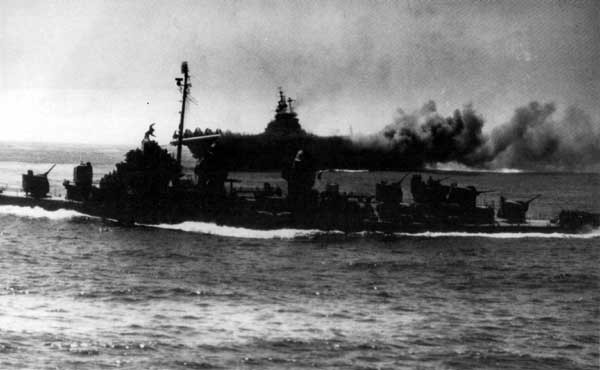
--49--
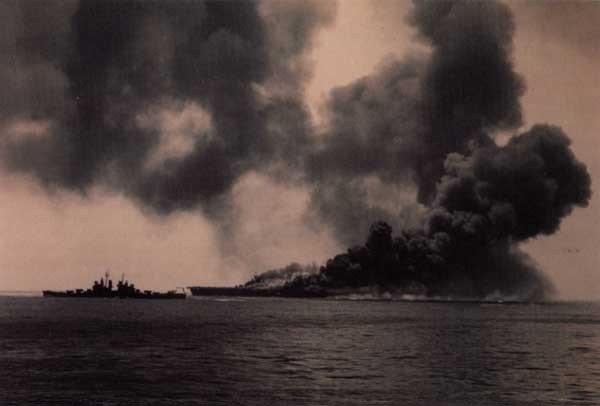
and were simply towed across the Pacific. Significant hull damage would no longer cripple the ships of a fleet thousands of miles from home.
This time at Guam was largely a period of rest and relaxation for many of the crew, but my 8th Division gun crews and I had an enjoyable and productive outing. As befitted the base of the U.S. Navy's Pacific Fleet, Guam had a well-equipped AATC at a pleasant spot near the shore, laid out according to the usual AATC setup. I immediately gained permission to take all of my gun crews there for several days. I don't remember how long we were there, but I do remember clearly the performance of my fine men. By this time, AATCs were generously supplied with drones, which added considerable realism to the exercise and afforded target behavior not possible with towed sleeves. My crew of hotshots destroyed the AATC's weekly quota of targets in an indecently and (from the management viewpoint) inconveniently short time. We soon ran out of drones. The commanding officer told me that they had had a lot of ships' gunners there, but they had never before seen shooting like this. Unfortunately, none of Idaho's other division officers took advantage of the opportunity afforded by the nearby AATC.
We enjoyed our stay but were reminded by the floodlight and machine gun that covered the forest edge all night long that there were still a number of armed Japanese troops hiding on the island. When I went for walks in the woods and along the beach each afternoon, I readily accepted the .30-caliber automatic carbine I was told to take with me as a sensible precaution. There were still a lot of survivors there whose actions
--50--
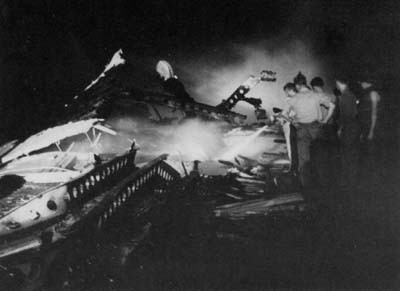
were unpredictable. Some managed to steal food, while others apparently were sufficiently bored by their isolation to sneak near enough to watch outdoor movies.
The slopes facing the beach were littered with the detritus of war, some of it quite grisly. The burial parties had hauled away the fallen Americans, but the far more numerous enemy dead presented a bigger problem. As most of them had died deep in their own bunkers and foxholes, our people improvised entombment by the simple device of merely covering the entranceways of their final retreats. Although a defense site had been occasionally overlooked, after the passage of 11 months, the insects and moisture of the tropical climate had removed most signs of humanity. An image that still sticks in my mind, however, is of a pair of shoes with the bones of the feet clearly visible inside.
There was actually a shoe warehouse near the AATC whose officer-in-charge was eager to distribute his wares. He not only gave each of us a pair of excellent mulehide shoes with composition soles intended for shipboard use, but insisted that if I told him the total number of men in our division, he would give me a supply of shoes for the entire division. He assured me that in the huge piles of shoes we took back in our jeeps everyone would find a pair that fit his feet. We took the shoes, and the supply officer was quickly proven correct— they did fit. What an excursion!
Our repairs completed, we left the dry dock and returned to Okinawa via Ulithi, arriving 21 May, having enjoyed a month's respite from the strain of battle. Though ours was a respite that crews of perhaps 200 ships of the Okinawa fleet eventually enjoyed, very few achieved this "surcease of sorrow" at so low a price. My friend Duly tells of "a description of the ships" in Kerama Retto following the 12 April attacks. It lists the various picket ships, most barely afloat, and Tennessee with its signal bridge burned out, before stating that "Idaho, with only a few ruptured blisters, looked like a man suffering from a hangnail in a hospital full of victims of a train wreck."
It is now time to close the circle of coincidence in which my AATC shipmates and I were involved. We were part of the two greatest carrier disasters of the Okinawa campaign, however tangentially in my case. In the 10 great Kikusui raids of Operation TEN Go, Idaho suffered direct attacks only in the first two on 6—7 April and 12—13 April. The result of my trip to Washington, D.C., in late 1944 had been my assignment to Idaho rather than to either Franklin or Bunker Hill, to which the assignment officer had originally intended to send me. Just by chance I got Idaho rather than Tennessee, which was the other possibility then available. By the time of Kikusui raids, beginning 6—7 April, Franklin had already been devastated. I had escaped that disaster which my old buddy Gus Greanias had described with such poignancy. I had seen Tennessee suffer severe casualties as we traveled in company on 12 April. Our Bermuda buddy Larry Springer had come unscathed through the suicide crash on Randolph at Ulithi on 11 March. It
--51--
remains only to recount the tale of Bunker Hill and the involvement of our old friend Ed Hills, the automatic weapons officer of South Dakota. It was another one of those carrier disasters that never should have occurred but somehow did, in spite of a couple dozen or more ships present for no other purpose than to prevent it. On 11 May at midmorning, Bunker Hill was crashed in rapid succession by two kamikazes, which came in completely by surprise. It is understandable that nobody could stop these two once they had made their appearance because the first came out of low clouds, while the second came in on the ship in a vertical dive. There had been no radar warning, and accordingly nobody had time to do anything. I later asked Ed how far away South Dakota had been from the carrier at the time of the attack, and he said, "About a ship's length." Once a carrier that is not "buttoned up" gets hit by two bombs, the damage and casualties are sure to be most severe. Bunker Hill suffered greatly from fire and smoke, and in fact a large proportion of her 396 deaths were caused by smoke inhalation. When I saw her on 14 May at Ulithi on her way home, she was a sad sight indeed—blackened all over from the fire and splattered throughout by great shrapnel holes, most of which, as in Franklin's case, were caused by the explosion of her own ordnance. The fast carriers suffered these terrible ordeals while protecting us and everyone else at Okinawa.
Back in the Fray
Following closely on our return to Okinawa on 23—25 May came another 165-plane raid, the seventh TEN Go, exceeded in size only by the previous raids of 6-7 April and 12-13 April. Yet Idaho's war diary for the period shows that following our arrival we carried out our normal bombardment mission at Okinawa, day after day and night after night, with relatively little interference from our aerial tormentors. Night after night we were virtually naked in fire support area number 5, continuously revealed to all eyes by our own illumination and harassment fire. We got so accustomed to such exposure that I don't even remember any unusual unease at the time. As had occurred during the third great raid on 15-16 April, and now in the seventh and eight raids of 23-25 May and 27-29 May, the slaughter of our radar picket protectors again proved frightful. They paid in blood for the relative freedom with which the bombardment ships were able to support the troops fighting ashore.
Analysis of Idaho's war diary gives us a fair idea of what was happening. During the seven days of 23—29 May, when these great raids were being directed against Okinawa, the war diary shows that "Conducter" gave "Exbrook" a "Flash Red" 12 times—these being equally divided between "Control Yellow" and "Control Green." His "Flash White" [All Clear] usually came after about 30 minutes but occasionally in as little as 5 minutes and as long as one hour. In all of this ordeal, we never saw a Japanese plane during daylight hours and saw only a couple of them at Yontan Airfield on the night of 24 May when a suicide squad arrived there in a belly-landing "Sally." "Flash Red" meant that we the bombardment ships would cease the exercise of our principal mission and stand around for a few minutes from time to time just in case a few Kikusui made it past our protective shield, as had happened on the afternoons of 6 and 12 April. Meanwhile, the gallant destroyers and gunboats with their overhead CAP were fighting it out and taking a beating in the exercise of their principal mission. Roland, on the pass in the Pyrenees at Roncesvalles, would have understood their sacrifice.
Although the seventh and eighth Kikusui raids in late May comprised a total of 275 planes, the ninth raid of 3-7 June, with only 50 planes, seemed no differ-
--52--
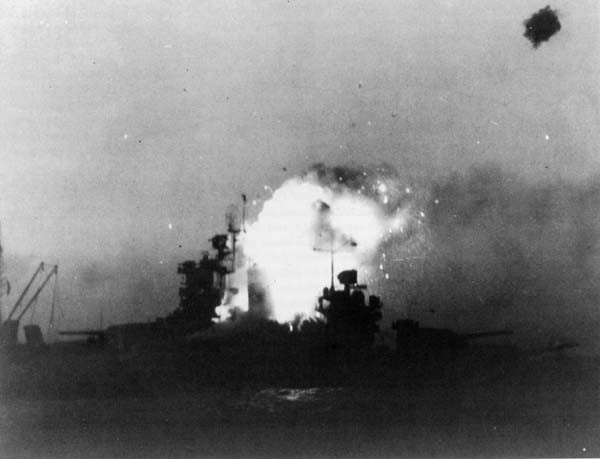
ent to us. We couldn't know the big picture, and we had no idea how many planes were coming. All we had to judge by was the IFD's announcement of "Flash Red," followed by the gong of the general alarm and the piercing notes of our bugler. These events never ceased to be arresting and even startling, and we never let down our guard. This index of peril continued steadily, and with no perceptible downward trend, right up to the day Idaho departed for the Leyte Gulf on 20 June. There had been 11 "Flash Reds" in the seven days of the big raids through 23-24 May. And during the 22 days from 30 May to 20 June there were 32 more, all these in addition to our unvarying dawn calls to general quarters. "Flash Red" was our only indicator of danger, and we had seen too much trouble to be lulled by the frequent cry of "wolf." As before, we stood around our battle stations and remained alert at all times, but we never saw a Japanese plane again. Our valiant guardians, the picket ships and the fast carriers, with their combat air patrols, were continuing to make sure that the troops ashore would not lack for the support of our deadly seagoing rifles.
Up to 13 June we had spent all of our time on the west side of Okinawa, often remaining throughout the night in our fire support area. When not engaged in these all-night illumination and
--53--
harassment missions, we anchored for the night in Hagushi Anchorage where the standard night protection was the employment of smoke generators. But on the 13th we moved briefly to the east side of the island and made our base in Nakagusuku Wan, later renamed Buckner Bay. After carrying out her bombardment mission for five days in Fire Support Sector III, on the final day, 18 June, Idaho fired her last hostile shots of the war:
1604 Ceased firing main battery.
1605 Ceased firing secondary battery.
1628 Proceeding Hagushi Anchorage. . . .
1858 Anchored berth H159, Hagushi Anchorage, Okinawa Shima.
Even then General Ushijima was preparing for hara kiri (ritual suicide), and the Okinawa campaign was about over. After remaining quietly at anchor on the 19th, we took our departure for Leyte Gulf the following day, leaving "iron wars" forever behind. Beyond our most unimaginable dreams at the time, our war was over!
After an uneventful voyage in company with the heavy cruiser New Orleans (CA 32) and a couple of destroyers, we reached San Pedro Bay in Leyte Gulf on 23 June. During this trip we had some quiet seas, which made possible the testing of VT-fused ammunition. We fired several rounds at a high angle and then waited to observe their detonation as they reached the sea at the end of their trajectory. Their explosion just before reaching the surface indicated that the delicate batteries were surviving intact in their storage in Idaho's magazines.
Except for antiaircraft firing exercises on 9 and 12 July, we remained at anchor from 23 June to 16 July, when we made the short trip to Guiuan Anchorage at Samar. There we spent 14 days in another floating dry dock undergoing various repairs. During this time I had a pleasant encounter with another old friend. While walking on Samar Island where I had taken a liberty party, I heard a voice behind me calling, "Bob Wallace, Bob Wallace." It was John Stadler, a nice student whom I had known in Lawrence, Kansas, while teaching at the University of Kansas from 1935 to 1937. John was on a destroyer and had great praise for his skipper, whose maneuvering skill had enabled them to dodge a kamikaze at Okinawa. Several such ships managed to perform this feat, at least partly because of the limited flying skills of those unfortunate, young Japanese pilots.
After emerging from dry dock on 29 July, Idaho continued intensive exercises, including both antiaircraft and main battery firing, with other ships. After all, we were preparing ourselves for Operation OLYMPIC, the invasion of Japan, scheduled to begin in November with an assault on the Japanese Home Island of Kyushu. But something was in the air. And except for a single antiaircraft practice on 8 August, we remained at anchor. We had heard some mention of atomic bombs being dropped on Japan, without understanding what they were. And then on 10 August, just before 2100, as I recall, we "received [the] report that the Imperial Japanese government had accepted the Potsdam ultimatum." Many ships in the anchorage went wild and sent skyward a chilling volume of friendly fire, as may be clearly seen in a timelapse photograph taken at the time. But Idaho, as befitted a dignified (and sensible) elderly lady, greeted the good news by "firing pyrotechnics in celebration thereof." The pandemonium was stopped promptly by the following message sent from the CNOB (Commander Naval Operating Base):
ALL SHIPS PRESENT: ALL
FIRING OF ANTIAIRCRAFT
WEAPONS FOR CELLEBRA-
TIVE PURPOSES WILL BE
DISCONTINURED ON
RECEIPT THIS MSG.
As I had done on that first night at Ulithi, now seemingly so long ago, I climbed to Sky Control, there to reflect on the sudden end of the great adventure. It is now hard to recall feelings and emotions so far in the dim past. Surely I was happy at the thought of sudden victory, but the thing I recall most clearly was a certain feeling of sadness. I had loved my Navy experience, and I had always delighted in the stirring spectacle of this great assemblage of warships and of being a part of it. Now it was over, and for the moment I could feel sad.
I have had many more adventures in the years since: exchanging
--54--
challenges with great bull elk on lonely backpacks in the Selway-Bitterroot Wilderness, hunting lions on foot in the Semliki Plain of Uganda, and spending many nights alone in trees, waiting for tigers in the jungles of Bhopal. All fabulous thrills, but none to match the Great Adventure of World War II. Similarly, as a visiting professor at the University of Florida and later at UCLA, I felt the great satisfaction of receiving standing ovations on the last day of class. But none of these receptions could afford anything like the wonderful feeling of fulfillment I had enjoyed from the respect and affection of my magnificent gun crews. We were indeed "a band of brothers." Never again in my long life would I feel that I had done anything so important.
Homeward Journey
A few days later, on 16 August, Captain Stanley D. Jupp relieved Captain Herbert J. Grassie as commanding officer of Idaho. Shortly thereafter we left Leyte Gulf for Buckner Bay, where we joined with other ships of Battleship Divisions 3 and 4 for the trip to Tokyo Bay and the surrender ceremonies. Along with several older battleships, Idaho remained in Sagami Wan, just outside Tokyo Bay, presumably to act as a covering force in case of any difficulties. We entered the bay only the day after the signing of the surrender documents on board Missouri (BB 63).
Two memories of the trip to Japan stand out. The night before reaching Japan we were lighted up brilliantly by billions of phosphorescent microbes, which were turned up by our bow waves and wake. Up in Sky Control, it seemed bright enough to read a newspaper. A few days earlier this impressive phenomenon had caused a false alarm among the Japanese defenders themselves. With their nerves on edge in anticipation of an American invasion, their leaders received a report that in the night two long columns of ships had been observed in these same waters. My other memory is also of a spectacular natural phenomenon. Late on the afternoon of 27 August, after anchoring in Sagami Wan, many of our crew exclaimed at the spectacle of the sun, which, just as it set behind Fujiama, cast forth the bright red bars of light so prominently seen on Japanese maritime flags. We knew we had come to the right place.
As we moved to Tokyo Bay on 3 September, I saw a small antique warship on the point at Yokosuka, which I immediately recognized as HIJMS Mikasa. This proud ship had been the flagship of Admiral H. Togo at Tsushima Straits—the battle in which he destroyed the Russian fleet in 1905. The grateful Japanese had preserved her as a national monument. Fifty years later, alongside my American Battleship Association companions, I spent a pleasant afternoon at Mikasa. It was there that we tossed two wreaths into the bay in memory of our fallen comrades on both sides and happily reminisced with our former adversaries on the great adventure we had shared together so many years ago.
After World War II, in the overzealous course of demilitarization, she had been stripped down and for a time lay in ruins, almost forgotten. But following restoration, with the backing of the U.S. Navy, she was opened again to the public on 27 May—the 56th anniversary of the Battle of Tsushima Straits. Japan's many American friends will be pleased to read the following handwritten message that was received at the opening ceremony:
To all those patriotic Japanese who helped to restore the famous ship—MIKASA flagship of Admiral Togo—Your greatest naval officer—with best wishes from a great admirer and disciple. C.W. Nimitz, Fleet Admiral, US Navy.
--55--
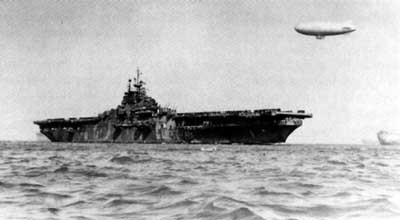
Down through the ages, war has been perhaps the greatest of all instruments of cultural exchange and development. Examples that quickly come to mind are the impact on Europe of contacts during the Crusades with the more advanced civilization of the Middle East and the creation of the English language as we know it, together with a complete change in the whole direction of English and European history following the Norman conquest. Can anyone doubt that Japan was the principal beneficiary of the great Pacific War, even though she also paid the highest price? Since Japan already possessed a culture that stressed excellence, efficiency, and duty, what she needed above all was the revolutionary influence of an open relationship with Atlantic society, something that was amply provided in the postwar period.
Given the sudden ending of this great war to which all our thoughts and exertions had been dedicated for so long, it was perhaps a bit hard to wind down. It felt strange at first not to go to dawn general quarters, but I imagine we fully realized that it was all over once we anchored in Buckner Bay at Okinawa on 9 September and spent the best part of the day striking below all 5-inch/38, 40mm, and 20mm ammunition. With all of our bullets sent down to the magazines, Idaho's antiaircraft battery was at last out of business.
The scuttlebutt (ship's gossip) was that at Okinawa Idaho would take on board as deck passengers a number of Army troops who, like many millions of other young Americans, were scattered all over the world and as eager to get home as we were. The Navy quickly realized it would have to use all of its ships returning to the United States to carry a great many passengers in the enormous task of repatriating U.S. armed forces, now suddenly idle. But Idaho did not have time to pick up our passengers. The two great typhoons, which had caused serious damage to the fast carrier forces, had made the Navy a bit edgy. The forecast of such a storm for Okinawa sent us packing at 17 knots. Our war diary for 10 September reports, "1730 Underway for Pearl Harbor, T.H."
Okinawa did experience a severe typhoon, which dragged ships at anchor across the bay and caused a great deal of damage. On the storm perimeter we encountered rough waters but nothing to cause even discomfort on board our battleship. Then at the beginning of each day for 10 subsequent days, the war diary laconically records, "Steaming as before." On 12 September, we "exercised at General Quarters for drill." It was perhaps a bit illogical since all of our ammunition was stored in the magazines, but it gave us something to do. For the most part during the voyage, people just sat around reading or sunbathing. The trip was monotonous but nobody complained. Finally, in the entry for 20 September, we read "1435 moored starboard side to guay [sic] 'F-6' Ford island, Pearl Harbor, Oahu, T.H."
Idaho was going from Pearl Harbor to the East Coast via the Panama Canal. Ernie Marx and I, both wanting to go to the West Coast, now left the ship and reported to Commander Service Force, who sent us to a staging center where we were assigned to the BOQ to await the next available transportation. Just before leaving Idaho, I received a message from Missouri:
--56--
MSG TO LT WALLACE X
HAVE BEEN TRANSFERRED
GOING HOME X GOOD-BYE
AND GOOD LUCK X LT
COMMANDER HILLS
We were all going home as fast as we could. Missouri soon came in, and I visited Ed there before they left. We kept in contact in the postwar years but did not meet again until I visited him 50 years later at his birthplace—his ancestral estate by the sea in Hingham, Massachusetts. Idaho departed Pearl Harbor on 25 September, but Ernie and I had a longer wait. I met my brother, Major John E. Wallace, who had been Chief, Forecast Section, U.S. Army Air Forces, in Washington, D.C. Now, with the war over in Europe, he was being staged west and, like Ernie and me, was just waiting. He invited us to lunch at the Officers' Club. We had been living on dehydrated vegetables for so long that I still remember that fresh zucchini on the menu that day.
Finally on 29 September 1945, we saw our names on the passenger list of an LST leaving the next day for San Francisco. Ernie, with serial number 103069 against my 191098, was a much saltier character than I, and he took the LST prospect in stride. But I had seen the Essex-class carrier Ticonderoga (CV 14) anchored out in the stream. As one who had ridden "blind baggage" in the night across Kansas on the Rock Island Colorado Flyer at the age of 16, I decided to utilize my old hitchhiking skills. I should explain that the archaic term "blind baggage" refers to riding with your back against a locked railroad baggage car and your feet perched on the crossbeam at the rear of the locomotive tender ahead. Accordingly, I picked up my suitcase the next morning and went down to the dock. Finding a Ticonderoga launch there, I told the boatswain in charge that I wanted to get out to the ship. When I reached the gangplank, as luck would have it, the officer of the deck happened to be the First Lieutenant (the ship's "housekeeper" or in this case the "desk clerk"). When I told him what I wanted to do, he said "no problem" and sent me off with a sailor as guide through the labyrinthine passages of that huge ship.
The sailor left me in a brightly lighted space with a long white counter running the width of the room but with unlighted emptiness behind. I looked back into the shadowy gloom and called out, "Anybody home?" From the darkness came the response, in a more or less rhetorical question, "Is that Bob Wallace out there?" Amazingly, it turned out to be another great kid from K.U.— another legacy of my earlier teaching career. He placed me royally in the flight officers' quarters forward where I shared a passenger cabin with a very companionable lieutenant commander. He was mourning his brother, one of the many suffocated by smoke in the conflagration on board Bunker Hill. We became good friends during our pleasant voyage to the Alameda Naval Air Station in San Francisco Bay.
My wife, Sara, was there on the dock as I came ashore. This was some days before Ernie Marx finally arrived. He had many relatives in San Francisco, and we had no trouble locating him. After a day or two of enjoying stateside life together, we headed for our homes. Our war was really behind us at last. Many years later, I was fortunate enough to visit Ernie at his home in St. Louis.
Now, after half a century, I still remember the many friends who did not make it through the war— Eddie Olson in Arizona, little Milton Davis from my hometown in Oklahoma, my friend Bobbie Fletcher whose Mustang was shot down in the last week of the war, and a host of others—all cut off in the bloom of youth, yet all forever young in my memory.
Man is not given to see the future, and in all of his struggles in war he can only hope that his sacrifices will somehow help to bring about a brighter new world. As we sat in Japan on 2 September 1995 with former comrades and former enemies, I kept turning over in my mind what the fallen on both sides would think of the war's eventual result—the world's two richest economies: America, "on the summit of the world" (as Winston Churchill put it), and Japan, Phoenix-like, risen from her ashes to challenge the whole world in peaceful commerce. If we could somehow persuade the Angel Gabriel to blow on his great trumpet the general quarters call for the two navies, from across the land and seas of half a world, would they not all rise and join us there? And seeing the result, would they not surely say, "It did turn out rather well, didn't it?"
--57--
About the Author
Robert F. Wallace, a Holton, Kansas, native with a lifelong passion for history, served as a teacher of economics at 11 different colleges and universities from 1935 until 1983. Beginning his teaching career at Kansas University, where he had received his baccalaureate and master's degrees in economics, he taught next at Park College in Parkville, Missouri, before enlisting in the U.S. Navy in 1942. He received his doctorate in economics in 1948 from the University of Minnesota. During 1952 and 1953 he was employed by the Central Intelligence Agency. His articles on economic history and Federal Reserve policy have appeared in such professional journals as the Journal of Finance and the Journal of Political Economy, while his pieces on big-game hunting—the stalking of tigers in India, lions in Uganda, and elk in the United States—have been published in American Rifleman. In 1977 he retired from Washington State University as professor of economics and department chairman. He last taught in 1983 at UCLA. He and his wife, Sara, have been residents of Pullman, Washington, since his retirement.
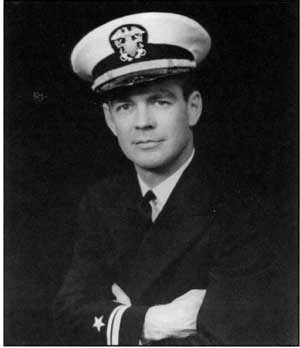
Suggested Readings
Barlow, Jeffrey G. "The U.S. Navy's Fight Against the Kamikazes." in New Interpretations in Naval History: Selected Papers from the Tenth Naval History Symposium, edited by Jack Sweetman. Annapolis, MD: Naval Institute Press, 1993
. _________. "The Battle for Okinawa." in Great American Naval Battles, edited by Jack Sweetman. Annapolis, MD: Naval Institute Press, 1998.
Friedman, Norman. U.S. Naval Weapons. Annapolis, MD: Naval Institute Press, 1982.
Gallery, Philip D. "Me and My Dam Neck." United States Naval Institute Proceedings 96 (December 1970):52-57.
Morison, Samuel Eliot. History of United States Naval Operations in World War II. Vol. 14, Victory in the Pacific, 1945. Boston: Little, Brown and Company, 1960.
U.S. Navy war diaries and action reports for World War II can be found in Record Group 38 (Office of the Chief of Naval Operations), National Archives and Records Administration, College Park, Maryland.
--58--
ODE WRITTEN IN 1746
How sleep the brave, who sink to rest
By all their country's wishes blest!
When Spring, with dewy fingers cold,
Returns to deck their hallow'd mould,
She there shall dress a sweeter sod
Than Fancy's feet have ever trod.
By fairy hands their knell is rung,
By forms unseen their dirge is sung:
There Honour comes, a pilgrim gray,
To bless the turf that wraps their clay;
And Freedom shall awhile repair
To dwell a weeping hermit there!
William Collins
1721-1756
Transcribed and formatted by Thomas Wildenberg, HyperWar Foundation



